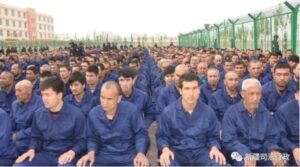
Detainees in the real brainwashing camps, where native languages are forbidden. Photo from Chinese social media; taken down after circulating outside China)
Testimony to the Cultural Property Advisory Committee, Bureau of Educational and Cultural Affairs, U.S. Department of State on the 2023 Request for Renewal of the 2019 Memorandum of Understanding Between the United States of America and the Peoples Republic of China
Submitted May 26, 2023 by the Committee for Cultural Policy and Global Heritage Alliance.[1]
“With regards to China, China continues to be one of the worst abusers of human rights and religious freedom in the world. They continue to engage in genocide and crimes against humanity against Uyghurs. They’re also continuing their repression of Tibetan Buddhists, Protestants, Catholics, Falun Gong, and Hui Muslims. …we’ve determined that China’s treatment of the Uyghurs constitutes a genocide and crimes against humanity… we have a number of tools that we’re using, including financial sanctions… [A]t the Human Rights Council this year the report on Xinjiang was finally released. And that report authoritatively describes the PRC’s appalling treatment and abuses of Uyghurs and other ethnic and religious minorities. We continue to see the situation worsening, and we’ll continue to use all the tools that I described to do everything that we can to help the people of China as they face repression at the hands of the government.”
Senior State Department Official on the 2022 Report on International Religious Freedom, May 15, 2023[2]
“Although a certain number of people who have been indoctrinated with extremist ideology have not committed any crimes, they are already infected by the disease. There is always a risk that the illness will manifest itself at any moment, which would cause serious harm to the public. That is why they must be admitted to a re-education hospital in time to treat and cleanse the virus from their brain and restore their normal mind. We must be clear that going into a re-education hospital for treatment is not a way of forcibly arresting people and locking them up for punishment, it is an act that is part of a comprehensive rescue mission to save them.”
An official Chinese Communist Party recording obtained by RFA’s Uyghur Service characterizes Uyghurs who have been sent for political “re-education” as “infected by an ideological illness.” Translated by RFA’s Uyghur Service, published August 8, 2018.[3]
I. INTRODUCTION

Tibetan protesters held by police. Courtesy Free Tibet.
The People’s Republic of China (PRC) has requested renewal of its January 14, 2019 Memorandum of Understanding (MOU) on cultural heritage under the U.S. Cultural Property Implementation Act (CPIA) with the United States.[4] This request for extension does not meet the legal requirements of the CPIA and should be denied.
Renewing this bilateral agreement would ignore China’s development of a multi-billion dollar art market that encourages domestic trade in the same items forbidden to U.S. museums and consumers and the PRC’s near complete dominance of the international market in Chinese art and antiquities.
Renewal would turn a blind eye to China’s deliberate destruction of thousands of cultural sites forming the heritage of its minority peoples. It would undercut U.S. efforts to prevent the entry to the U.S. of goods made by slave labor by Uyghur camp inmates and former detainees who are shipped to locked factories throughout China.
Crucially, renewal would implicitly recognize the Chinese government’s right to define, control, and even destroy art and cultural heritage throughout its territory – including Tibet, Xinjiang, Mongolia, and Hong Kong.
Since one of the criteria for renewal is that China is “protecting” its heritage, renewal of the MOU would provide diplomatic cover for the PRC’s denial of its State-sponsored genocide and cultural destruction in Xinjiang today. It would support the PRC’s propaganda campaign to hide its crimes from the mass of the Chinese people and the international public. It would give the PRC another tool to utilize in the deliberate erasure of the cultures, religions, and languages of China’s minority peoples.

Demonstration for the rights of the Uyghurs in Berlin, Author Leonhard Lenz
19 January 2020, CC0 1.0 Universal Public Domain Dedication.
This is the fourth renewal of a five-year blockade on the importation of certain periods and types of art from China into the U.S. Museums, historians, collectors and traders reacted with outrage to China’s first request in 2005 to block access to art through the end of the Qing Dynasty in 1912. On January 14, 2009, however, a more limited MOU was signed that placed import restrictions on art and artifacts from the prehistoric through end of the Tang period (approximately 907 CE) together with monumental sculpture and “wall art” at least 250 years old. The MOU was renewed in 2014, and in 2019, the U.S. signed a third five-year agreement renewing the China MOU despite serious public concern over the abuse of human, cultural, and religious rights in Tibet, Xinjiang, and Mongolia, and reports of government-sanctioned destruction of thousands of mosques, shrines, and monuments filtering out of China. Although by 2019 the State Department’s Human Rights and Religious Freedom sections had already condemned China’s appalling human rights abuses against its Buddhist, Muslim, and Christian populations and documented its destruction of religious monuments, the State Department’s Cultural Heritage Bureau and CPAC turned a blind eye to China’s policies of cultural erasure and its state-mandated destruction of languages and ethnic identity and renewed the agreement.
China’s 2023 request for a fourth five-year renewal of the MOU should be denied on legal, moral, and ethical grounds. The legal reasons for terminating the MOU are undeniable. The request for renewal fails to meet any of the Four Determinations of the Cultural Property Implementation Act, the legal criteria for continuation or renewal of an existing MOU. Arguments for denial on these legal and moral grounds follow below.
SUMMARY
The First and Third Determinations cannot be met. China’s domestic, legal market for Chinese art and antiquities is by far the largest in the world, and the second largest art market overall. China is an importer, not an exporter of Chinese art: its massive domestic market is draining the rest of the world of collections made in the 19th and early 20th century. China’s own market absorbs any minimal sale of illicit goods in the country. Its heritage is not subject to pillage in which the United State plays any part. China is a totalitarian surveillance state that is fully capable of monitoring and halting the looting of monuments and archaeological sites, and of controlling illicit exports. There is no evidence otherwise.
Renewal would be contrary to the Second and Fourth Determinations. China is not “protecting” its heritage, it is destroying its minority Tibetan and Uyghur heritage in a deliberate cultural erasure[5] that makes a mockery of the Second Declaration. The Chinese government officially considers non-Han, minority culture a “disease.”[6]
Renewing the MOU would be a travesty, shredding U.S. support for religious and cultural freedoms. Far from being in the international community’s interest in cultural exchange, renewal would run counter to international principles that abhor government’s egregious abuse of human, religious and cultural rights.
Renewal would deny every fundamental democratic value the U.S. stands for. It would signal to China that the U.S. will turn a blind eye to the worst and most deliberate violations of human, religious and cultural rights taking place in China today, with the full knowledge and support of its totalitarian regime.
One of newly appointed U.S. Secretary of State Anthony Blinken’s first important acts was to emphasize the close connection between human, social, and cultural rights, when he announced publication of the Department’s Country Reports on Human Rights Practices in March 2021.
The report stated:
“Genocide and crimes against humanity occurred during the year [2020] against predominantly Muslim Uyghurs and members of other ethnic and religious minority groups in Xinjiang. These crimes were continuing and included: the arbitrary imprisonment or other severe deprivation of physical liberty of more than one million civilians; forced sterilization, coerced abortions, and more restrictive application of the country’s birth control policies; rape; torture of a large number of those arbitrarily detained; forced labor; and draconian restrictions on freedom of religion or belief, freedom of expression, and freedom of movement.”[7]
CPAC’s rubber-stamp on a China renewal would be a mark of shame and hypocrisy – characterizing China’s ongoing policy of destroying Muslim and Buddhist living culture, as well as thousands of monuments, cemeteries, mosques, and monasteries, as “preserving heritage.”
II. THE FOUR LEGAL DETERMINATIONS CANNOT BE MET
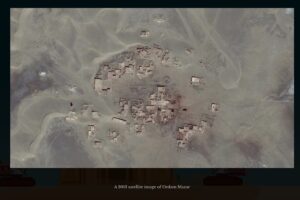
2013 satellite image of ancient shrine Ordam Mazar, Nathan Ruser , Dr James Leibold , Kelsey Munro & Tilla Hoja, Cultural erasure, ASPI, 24 September 2020, https://www.aspi.org.au/report/cultural-erasure
Section 2602 of the Cultural Property Implementation Act (“CPIA”)[8] provides that the United States may grant an agreement, whether by Memorandum of Understanding or otherwise, that implements the importation restrictions of Article 9 of the 1970 UNESCO Convention,[9] but only if all four parameters are met. These criteria also apply to continuations of bilateral agreements. The CPIA also states that the President shall suspend import restrictions if the State Party has not implemented such restrictions satisfactorily and there has been no substantial benefit to deterring pillage within that State.[10]
FIRST DETERMINATION: 19 U.S.C. § 2602(a)(1)(A) CPAC must determine that the cultural patrimony of the State Party is in jeopardy from pillage. [11]
- China is an autocratic, highly policed nation with full power to protect its patrimony, but which uses U.S. import restrictions instead to protect and benefit its domestic market. The legal and practical rationale for imposing import restrictions under these circumstances does not exist; it is entirely contrary to the goals and purpose of the CPIA.
- There is no evidence that any of China’s cultural property is at serious risk of pillage, as required by the Cultural Property Implementation Act. There has been little or no evidence of criminal looting of cultural property in China for more than a decade. The import restrictions currently imposed on Chinese art are impermissibly broad, applying to all art and artifacts from prehistoric times through the Tang period, and monumental sculpture and wall art over 250 years old, without any evidence that any of these objects are currently subject to pillage.
- Nothing important is being taken illegally from China today. The most recent return of an item of Chinese cultural property of any value are two stone beds, on loan to NY’s Metropolitan Museum since 1998, that the NY DA stated were looted and smuggled out of China in the early 1990s.[12] These objects, whose history of leaving China is unknown and one of which was displayed for 30 years by one of the most visited museums in the world, are by far the most valuable objects returned to China in decades and were never subject to the U.S. MOU.
- China’s government is more than capable of controlling illicit excavation and heritage destruction that is not, in fact, part of China’s state-sanctioned campaign to destroy minority heritage. China prides itself on its domestic oversight and control of its population. Under Xi Jinping, China has built the world’s most repressive, authoritarian surveillance state, utilizing both sophisticated technology and community networks of informers to pinpoint all activities its government deems anti-social. China is unquestionably capable of halting looting and domestic trade in looted objects on its own.
- China is the largest importer of Chinese art in the world. If there is any treasure-hunting for Chinese artifacts, it is so objects can be sold in within China’s own burgeoning domestic market, not for export to the U.S. or any other country.
- The cultural patrimony of Tibet and Xinjiang in China is indeed in jeopardy of destruction – but only through China’s official government policy of destroying the heritage and traditional culture of non-Han minorities.

Complete destruction of Ordam Mazar, Cultural erasure, ASPI, 24 September 2020, https://www.aspi.org.au/report/cultural-erasure
SECOND DETERMINATION: 19 U.S.C. § 2602(a)(1)(B) The State Party must have taken measures consistent with the Convention to protect its cultural patrimony.
- Far from ‘protecting’ heritage as defined under the 1970 UNESCO Convention, the Chinese government today preserves only Han Chinese culture, which it deems superior to minority cultures. China has destroyed thousands of Tibetan, Uyghur, and Kazakh monuments, mosques, shrines and cemeteries. It is China’s current official policy to bulldoze ancient built heritage as “unsafe” and then recreate sanitized, depopulated models conforming to government-approved or Disneyfied versions of minority heritage. Examples include the destruction of centuries-old public buildings and uprooting thousands of Uyghur graves from ancient cemeteries to turn them into “kitschy” panda-decorated parks.[13]
- China arrests and silences the living voices of Uyghur and Tibetan culture. Thousands of academics, archaeologists, anthropologists, teachers, historians, monks, imams and other religious figures, poets, dancers, and musicians engaged in studying, preserving, and participating in traditional culture have been incarcerated, tortured, and killed.[14] For a villager to possess a Koran is a criminal offense. Teaching Tibetan religion is illegal, even for parents, and young people are not allowed to attend religious services and festivals. Buddhist monks and nuns are forced to use “translated” approved texts in Mandarin in which Buddhism must support China’s Communist Party.[15]
- The U.S. State Department reports that in Xinjiang, over 800,000 children as young as toddlers taken from parents jailed in concentration camps are locked in ‘orphanages’ where they cannot speak their own language and are taught to hate their culture.[16] In Tibet, children are forced to attend Mandarin language ‘boarding schools’ that are often hundreds of miles from their villages. When they return home once every few months or once a year, they can no longer understand or speak to their minority-language speaking grandparents.[17]
- China’s government pursues an active policy of rewriting the history of minority peoples, denying that Tibetan, Uyghur, and Mongolian regions were ever countries independent of China. Chinese academics now falsely portray the history of Tibetans, Muslims, Mongols and other minorities as barbarian, dirty, and primitive, and teach this false history in minority regions and across China.[18]
THIRD DETERMINATION: 19 U.S.C. § 2602(a)(1)(C) Implementation of the import restrictions must be in concert with “similar restrictions implemented or to be implemented within a reasonable period of time, by those nations (whether or not State Parties) individually having a significant import trade in such material,” such restrictions “would be of substantial benefit in deterring a serious situation of pillage,” and “remedies less drastic than the application of the restrictions set forth in such section are not available.”
- The current MOU does not discourage the market in antiquities in China. Nor does Chinese law, which allows the sale of cultural property unless it is already owned by the state.[19] China’s import regulations now enable Chinese citizens to acquire Chinese art and antiquities in foreign venues and to bring them into China – and then to reexport them![20]
- China’s market for antiques and antiquities is now the largest in the world. There is no evidence that U.S. trade in Chinese art is detrimental to the preservation of China’s heritage or that the current MOU discourages sales of illicit objects in the United States. In fact, the MOU facilitates Chinese auction houses’ domestic monopoly at the expense of U.S. businesses and consumers. The MOU blocks U.S. imports of objects that are legally sold in in Chinese auctions and galleries supervised by its government; the largest auction houses in China are actually linked to government, military, and former PRC leaders.[21]
- The developed market nations of the U.S., U.K. and E.U. have a net outflow of Chinese art to China far larger than any of their internal markets. In contrast, China’s internal market for Chinese art has been far larger than all other world markets combined since 2009.[22] All other world markets for Chinese art are dependent upon Chinese demand. As early as 2012, 70% of the dollar value of Chinese art sold by Bonhams, Christie’s and Sotheby’s auction houses was sold to Chinese buyers.[23]
- China uses US import restrictions to benefit its own domestic market monopoly, not to deter pillage. China is the largest market nation for Chinese art, making the question of whether there are ‘similar restrictions’ in other markets moot.
- China’s import embargo only extends to the U.S. Major traders in Chinese art, which include Japan, Taiwan, Singapore, the UK, Belgium and France do not impose “similar restrictions,” a statutory requirement. Imports to their countries from mainland China and Hong Kong require only legal export from China, which retains its export documents, whereas U.S. Customs requires other official documentation often impossible to obtain, especially for Chinese art long held outside China in Japan, Singapore, the U.K. or E.U.. Thus, restrictions can apply to any works for which U.S. Customs sets its own documentary requirements. Yes, China’s government has signed bilateral agreements to return illicitly exported artifacts with Peru, Greece, Egypt[24] and Switzerland[25] (of which only Switzerland has even a small Asian art market). Unlike the U.S. MOU, these agreements do not rest on any imminent threat to Chinese cultural heritage nor do they impose the same strict import provisions as the U.S.
- Given the overwhelming market for Chinese antiquities in China, and the total lack of evidence of looting for the U.S. market, China clearly has access to “remedies less drastic than the application of restrictions”[26] and that action by the U.S., either alone or in concert with other nations, would not be of substantial benefit in deterring a serious condition of pillage.”[27]
FOURTH DETERMINATION: Application of United States import restrictions must be consistent with the general interest of the international community in the interchange of cultural property among nations.
Although Chinese law ostensibly allows export of legally purchased items by foreigners, China has failed to define rules for export or to establish functional government systems for lawful export by U.S. buyers. Hong Kong, controlled by China, has a major art market, but China has not established an office of the Cultural Relics Bureau there that could issue the type of permits now required by U.S Customs.[28] Thus, museums and collectors from everywhere but the U.S. can legally acquire art from Hong Kong. At the same time, the Chinese government has made it easier for Chinese citizens to purchase Chinese artworks from foreign countries, import them into China and then re-export the same objects.[29]
- At prior renewal hearings, including in 2018, the Association of Art Museum Directors stated that promises made by China to enable international loans under prior MOUs had not been fulfilled: no progress had been made on enabling longer than one-year loans of artworks, eliminating possibilities for many traveling exhibitions, Chinese exhibition fees and costs were very high, and the number of important objects in an entire government-approved exhibition could be as low as a single object. All these factors hamper U.S. museums’ ability to efficiently organize travelling shows at reasonable cost and deny even non-commercial cultural exchange.
- The CPIA’s fourth determination encourages the interchange of cultural property between nations. Depriving the U.S. public and cultural institutions of access to the international market denies important opportunities for education, scholarly study, and a better understanding of a key global partner. The Chinese government’s development of trade only for the Chinese market fosters and promotes China’s anticompetitive and isolationist commercial strategies. These strategies are incompatible with the CPIA’s requirement that import restrictions are “consistent with the general interest of the international community in the interchange of cultural property among nations for scientific, cultural, and educational purposes.”[30]
There is no evidence that US import restrictions will have any effect on pillage in China. The U.S. market in antiquities is so small compared to that of China and Hong Kong that import restrictions will harm U.S. interests without benefiting China – or enabling lawful cultural exchange.
China does not meet the legal preconditions in the CPIA for an MOU limiting the importation of cultural property. The President may extend agreements under Section 2602(e) of the CPIA only if the four factors justifying imposition of import restrictions still exist and there is no cause for suspension. As shown above, the four factors justifying restrictions cannot be met.
CPAC’s administration by the Department of State has been consistently criticized, both for secrecy and for bias toward national and archaeological interests over other constituencies including museums and academic scholars in fields such as history and art history. The interests of auction houses, art dealers, and collectors in a lawful trade, explicitly recognized by Congress, have been ignored.
As Congress feared, under the administration of the Cultural Heritage Center at the Department of State, the CPIA has actually harmed US cultural interests while being used as a tool to further soft power and diplomatic goals. It is long past time to halt these abuses. Renewal would be contrary to the law’s provisions and its purpose. The China MOU should not and cannot be lawfully renewed.
III. CHINA’S ART MARKET
It is impossible to reconcile U.S. import restrictions with the booming market for Chinese artwork and antiquities in Mainland China and China-controlled Hong Kong.

Grand Hyatt Hotel Hong Kong, Poly Auction preview Oct 2017 Lot # 3107. A CARVED WOODEN FIGURE OF GUANYIN, MING DYNASTY, 14TH – 17TH CENTURY.
China now has the second largest art market in the world, with the vast majority of artworks being of Chinese origin. China’s market went from zero in the 1990s to a billion-dollar annual internal market in art of all periods today. China’s domestic market allows sales of the exact same antiques barred from U.S. import.
In 2011, during the first U.S.-China MOU, the Chinese auction market surpassed all other countries in the world with $9.3 billion in total sales value.[31] In 2017, the year of the most recent MOU renewal, analysis of China’s internal market showed that the Chinese modern and classical paintings categories were almost 66% of market share, Chinese works of art (antique porcelain, jades, bronze) were almost 21%, and Chinese contemporary art was about 5%.[32]
Historians of China’s art and antiquities market trace its development to government sponsorship in the 1960s, when political and economic ties with the Soviet Union were greatly reduced. Premier Zhou Enlai encouraged major sales of Chinese antique art and antiquities by state-owned stores to foreign tourists and collectors in order to build foreign currency reserves.[33]
This ended with the 1966-1976 Cultural Revolution, when sales were halted, collecting antiquities was forbidden in China and many ancient and antique objects were deliberately destroyed. The reopening of China reversed the situation, and with development of its market economy, China’s art market has become second to none.
- 1972 – 1993 Nixon’s visit to China normalized relations and state-owned antiquities stores reopened for sales to foreigners. Buyers, largely from Japan, Singapore, Hong Kong, and Taiwan, used Western-style marketing skills to reach collectors and museums in the U.S., UK and Europe.
- 1991 The first private contemporary gallery and the first museum showing a private collection.
- 1991-1993 Massive growth of China’s economy enabled wealthy individuals in China to begin collecting art, resulting in record-breaking prices of Asian art worldwide. Premier Deng Xiaoping encouraged the transfer from a totally State-controlled economy to a market economy. China’s first auction house, Shanghai Duo Yun Xuan Auctioneer Co., Ltd, was established using the inventory of one of the largest state-owned antique stores in Shanghai. The first art fair was held in China.
- 1994 The state-backed China Guardian Auction House held its first auction in Beijing. Auction houses obtained artworks for sale from state-owned antiquities shops.
- 1995 Over 30 auction houses were founded in China and the first auction laws were passed.
- 1997 Sovereignty of Hong Kong was transferred from UK to PRC.
- 2004 First professionally organized art fair held in China, the China International Gallery Exhibition.
- 2005 Poly International Auction Co., Ltd. Established (parent company is Poly Culture Group, originally People’s Liberation Army)
- 2007 Proliferation of international art fairs held in China.
- 2004-2011 Phenomenal growth in China’s art market, in part because art was seen as an investment vehicle for fast profits. Study by Artnet and the China Association of Auctioneers showed auction market for art and antiques in mainland China experienced 500% growth between 2009 and 2011.
- 2012-2013 Sotheby’s and Christie’s open in Mainland China.
- 2014, import into China of art, antiques, and collector items increased at 2281% rate.
- In 2016, while sales at New York auctions were falling, mainland Chinese art market revenues remained high at $12 billion, due to increased Chinese nationalism and use of art as a popular short-term financial strategy.[34]
- 2012-2018 Markets adjusted down -53% as short-term investors exited, but serious Chinese buyers continued and established private museums.
- 2014- 2017 Auction houses grew to 525, total sales to US $4,791,000,000. Sales from mainland Chinese auction houses account for more than 80% of worldwide auction sales in every category.
- 2017-2019 First foreign museum partnerships established in China, including with the Los Angeles County Museum of Art and London’s Victoria and Albert Museum.[35]

Bonhams Auction, Island Shangri-la Hotel, Admiralty, Queensway, Hong Kong, Author: Umuiowiadupia, November 2013, via Wikimedia Commons.
China’s art market was briefly affected by worldwide COVID. However, the most recent reports from Hong Kong, now firmly in the hands of the mainland Chinese administration, show that the art market there as well as in Shanghai, Beijing, and other art centers has come back with a roar. The market for Chinese art is certainly not exclusive to China – the U.S., U.K. and European venues are still major markets for Chinese art, but Chinese buyers who are importing art back to China are the most significant buyers in the U.S., U.K. and E.U.
Traditionally, mainland China’s strongest art-trading partner was Hong Kong,[36] where goods flowed to other Asian, U.S. and European buyers. The Hong Kong commercial market exists only with the permission of the People’s Republic of which it is now a part. The primary market for Hong Kong auctions and sales are collectors inside Mainland China, and international auction house sales of Chinese art and antiques have shifted significantly to Hong Kong for the convenience of these Chinese collectors.[37] Unfortunately, Hong Kong does not have facilities for issuing export permits of the kind required by the U.S., so U.S. collectors and museums are unable to legally import items from Hong Kong as other countries can.
Despite its pro-archaeological rhetoric, China’s cultural property law expressly permits Chinese citizens to purchase cultural relics from stores, auction houses, and “other lawful channels prescribed by the State.” In 2011, China’s State Administration of Cultural Heritage 11th Five Year Plan set the goal of having over 3,500 museums in China by 2015. China has adopted policies and regulations that make it easy to import and re-export art Chinese art and antiquities in China, incentivizing demand within China and facilitating Chinese access to material denied to US museums and collectors.[38]
According to a major report on China’s art market by TEFAF in 2019 there is little evidence of looted materials found within China’s vast and highly regulated domestic art market. Research published in 2020 by Zhao Qiang on auction risk management found only 23 cases of stolen art or antiques at auction between 2002 and 2019. The auction houses were in Bejing, Shanghai, Zhejiang province, Hubei province and Hong Kong and all the objects were stopped from sale. The most valuable was a 20th C painting valued at $480,000 U.S. entered for sale at Sotheby’s Hong Kong in 2019.[39] More common are ordinary criminal thefts from homes, institutions, and libraries for lower value materials such as books and manuscripts, which are then sold on the Chinese market.
It is important to understand that an MOU on Chinese objects has an impact on U.S. access to a far broader range of materials than just those appearing on a Designated List. Today, U.S. Homeland Security is seizing objects based simply on their Chinese origin, regardless of the country of importation – and on the fact that Chinese laws can prohibit export of objects up through 1949. In China, “antiquities” include revolutionary period materials from the 20th C. China restricts the sale of virtually all forms of historical materials of the Revolution and monitors sales even in small auction houses.
The Chinese press provides little evidence of looting. There is no evidence of theft that would have been impacted by an MOU. Chinese police have been able to identify and track sales from “inside job” thefts such as a 16 year-long case to track the theft of an early 20th C literati’s papers from a regional library.[40] This major domestic theft case was hailed as part of a yearlong joint project of China’s cultural heritage administration and police that solved “2,200 cases of cultural-heritage-related crimes involving the recovery of 58,000 antiquities,” from the manuscript and book inventory of libraries and archives.[41] There was no mention of foreign smuggling. Archeology-related looting is not a common factor in art theft, and objects taken in domestic thefts are for distribution in the domestic Chinese market, not export. If objects stolen from inventory were exported, they would not need to be covered by an MOU. Objects stolen from homes or institutional inventories are already subject to seizure under the CPIA’s Section 301[42] as well as under a U.S. theft statute, the National Stolen Property Act of 1934 (NSPA).[43]
IV. CHINA IS DESTROYING THE HUMAN, RELIGIOUS & CULTURAL RIGHTS OF MINORITIES
“The United States will not stand idly by as the CCP carries out human rights abuses targeting Uyghurs, ethnic Kazakhs, and members of other minority groups in Xinjiang, to include forced labor, arbitrary mass detention, and forced population control, and attempts to erase their culture and Muslim faith.”
U.S. Secretary of State Mike Pompeo, June 17, 2020.[44]
China does not meet the legal preconditions in the CPIA for an MOU limiting the importation of cultural property. Most significantly, China has not met the requirement that “the State Party has taken measures consistent with the Convention to protect its cultural patrimony.”
Even before the Cultural Revolution, there was overt state control of religious practices in China. The Communist Party of China (CPC) is by definition made up of atheists. The CPC has a mandate: to promote a unified socialist China in full alignment with the laws set forth by the Party. While China’s state policy is officially “tolerant” of minority peoples, it no longer accepts any divergence from a Han Chinese norm. Contemporary expressions of diversity in cultural heritage are now limited to celebrating folk customs of the types pleasing to tourists, particularly those incorporating pageantry and telegenic costuming. The State Department’s Cultural Heritage Bureau must be aware of the DOS’ designation of China as a “Country of Particular Concern” since 1999 under the International Religious Freedom Act (IRFA) and its statements that today, China’s government is pillaging and destroying its own cultural heritage.

Uyghur scholar Muhammad Salih Hajim, 82, who died in January 2018, about 40 days after he, his daughter and other relatives were detained, according to the Uyghur Human Rights Project (UHRP).
China watchers have long expressed concern about the government’s religious intolerance. This includes the military police’s blowing up ‘unregistered’ Christian churches and removing crosses even from officially registered churches, punishing expressions of minority and indigenous identity with imprisonment, and imposing harsh penalties on law-abiding citizens for their religious beliefs.
In January 2018, Chinese military police in Linfen, Shanxi Province used explosives to demolish the Golden Lampstand Church, an unregistered Protestant church said to have 50,000 members.[45] Its congregants had undergone repeated prosecution since they broke ground on the building in 2009. Church members who have protested its destruction have suffered beatings, arrests, up to seven years’ imprisonment, and heavy fines for their devotion. This time, they could do nothing to prevent its complete demolition. A campaign in Zhejiang Province began in 2015 to remove crosses from the tops of church buildings.[46] By 2018, it was estimated that 1200-1700 crosses had been knocked down and forcibly removed.[47]
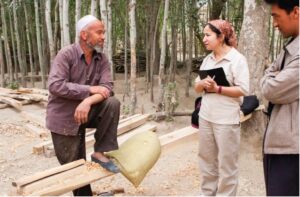
The Uyghur folklorist Rahile Dawut conducting research at a mazar shrine, ca. 2005. She was “disappeared” in 2017, whereabouts still unknown.(Screenshot from Lisa Ross 2019)
China’s pressure to Sinicize Chinese Mongolia is less well-known than its replacement of traditional culture with Han Chinese and Communist interpretations in other regions. Chinese law guarantees all children the right to an education in their native language. However, at the end of August 2020, curriculum changes replaced Mongolian language instruction and textbooks with Mandarin substitutes. All children’s television in Mongolia has now been replaced with Mandarin programming.
China’s government’s most brutal campaigns to destroy cultural and religious heritage are taking place today in Tibet and Xinjiang. China’s goal is to erase Tibetan and Uyghur identity, cultural traditions, language and religion, eliminating religious and cultural diversity and raising Han Chinese cultural norms, language and identity above all others.
During the 2018-2023 5-year MOU with China, U.S. and European governmental bodies and NGOs stated that China’s government policies against its Muslim minorities constituted genocide.[48] During this limited time frame, in Xinjiang province alone, the PRC has imprisoned a million innocent people, subjected tens of thousands to torture, forced sterilization, and forced labor, and taken nearly a million infants and children away from parents and relatives and into state-run orphanages, where they are given new names, indoctrinated in Chinese Communist Party doctrine and taught to speak exclusively Mandarin Chinese language.[49]
V. TIBET (TAR)
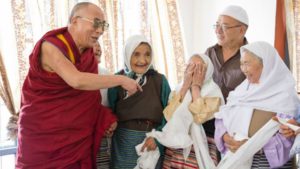
The Dalai Lama with Tibetan Muslims. Photo: Voice of America. The Dalai Lama first met with the Srinagar Tibetan Muslim community in 1975 and later again in 1988 and has continued to keep in touch with the situation of Tibetan Muslims who have a distinct identity as both Kashmiri and Tibetan.
Tibet was forcibly joined to the People’s Republic of China after an invasion by Chinese forces starting in 1950 that was given legal color through the coerced signing of the Seventeen Point Agreement in 1951. Between the 1950s through the Cultural Revolution ending in 1976, 1.2 million Tibetans were killed and all but 13 of the country’s 6,254 monasteries were destroyed.[50] The Dalai Lama fled to India in the wake of the Lhasa Uprising against a brutal Chinese occupation in 1959. According to scholar Peter Dziedzic, the number of nuns and monks in Tibet was reduced by 93 percent.[51]
Key elements of China’s current campaign to suppress Tibetan culture are the destruction of places of worship, an education policy that forces Tibetan children across the country into boarding schools, pressuring monks, nuns, and the general population to disavow the Dalai Lama’s teachings in favor of a Sinicized religion, and the physical destruction of monuments and holy places.
Boarding schools.
In Tibet today, a major new campaign has closed Tibetan-language schools across the countryside and forced hundreds of thousands of Tibetan children into locked boarding schools, often hundreds of miles from their rural families. On 6 March 2023, the United Nations Committee on Economic, Social and Cultural Rights (CESCR)[52] condemned China’s coercive residential school system in Tibet that takes 1 million children from their homes and parents. The Committee issued its observations on March 6, 2023, describing the closing of Tibetan language-based schools and “the large-scale campaign to eradicate Tibetan culture and language, as well as the general undermining of the linguistic identity of ethnic minorities by the assimilation policy… including the coerced residential (boarding) school system imposed on Tibetan children.”[53]
Suppression of religion.
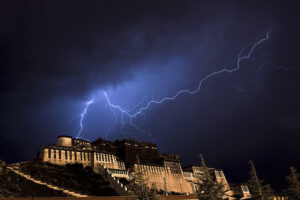
Lightning over the Potala Palace in Lhasa, Tibet, Author: 李国强, 11 August 2011, Creative Commons Attribution-Share Alike 3.0 Unported license.
In 2018, the US Senate passed a Resolution 429[54] condemning the Chinese government for engaging in “the severe repression of Tibet’s unique religious, cultural, and linguistic heritage” and for “gross violations of human rights in Tibet, including extrajudicial detentions, disappearances, and torture.” Congress’ source for this information was the State Department’s own Human Rights Report.[55]
The Resolution marked the 10th anniversary of protests in Lhasa and across Tibet, which Chinese forces violently suppressed. It noted that “in the ten years since the 2008 protests, at least 152 Tibetans in Tibet are known to have self-immolated… calling for freedom for Tibet and the return of the Dalai Lama.”
The Senate affirmed its “support for the Tibetan people’s fundamental human rights and freedoms, including their right to self-determination and the protection of their distinct religious, cultural, linguistic, and national identity.”[56] (my emphasis)
As early as 2007, China passed regulations banning the reincarnation of Buddhist monks without first obtaining government approval.[57] The United States Commission on International Religious Freedom (USCIRF) stated in their 2017 Report that “[t]he Chinese government claims the power to select the next Dalai Lama with the help of a law that grants the government authority over reincarnations.”[58] The Dalai Lama rejects this entirely, raising a number of other possibilities: that that he intends to reincarnate outside China, may choose to reincarnate as a woman, or utilize other traditional options for naming another form of religious successor.[59]
The Chinese government concentrated early on removing potential religious leaders as the focus of Tibetan cultural independence. In 1995, after the death of the Panchen Lama, the Chinese government kidnapped the six-year-old boy identified as his reincarnation, together with his family. He has not been seen since 1995.[60] The government appointed its own 7-year-old Panchen Lama,[61] who makes periodic public appearances in Tibet to tout Chinese government policy but is shunned by Tibetans except those forced to endorse him, according to the Congressional-Executive Commission on China.[62] Traditionally, there are hundreds of recognized reincarnated spiritual authorities in Tibet. Today reincarnate beings must apply for and obtain government approval in a process that legally obligates them to swear loyalty to Xi Jinping and the communist State, to promote its policies, and to disavow the Dalai Lama.
Destruction and desecration of holy places.
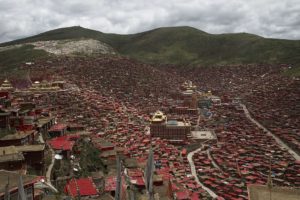
Larung Gar Five Sciences Buddhist Academy, 2014, Author Boddhicita, from Chung Du Shi, China. Wikimedia Commons.
Many Westerners are familiar with the ongoing destruction and removals from the famous Buddhist center at Larung Gar in Tibet. Larung Gar was founded as a non-sectarian Buddhist “mountain hermitage” rather than a monastery by Khenpo Jikphun in 1980. Larung Gar became a thriving center of Buddhist education, supporting thousands of monks and – notably – nuns from across the Tibetan Plateau in their scholastic efforts. Although the hermitage has been allowed to continue its education program in a limited way under Chinese supervision, in 2016, the Chinese government announced the demolition of dwellings and forcible removal of 50-75% of the nuns, monks, and lay residents, reducing the population to a government-set ceiling of 5000 persons.
The destruction of Buddhist heritage in lesser-known regions of Drago County in Tibet has been documented in a January 2023 Report by Tibet Watch and Free Tibet.[63] This detailed report makes plain the extreme measures taken by authorities even in small towns to suppress any form of religious expression and the brutal punishments inflicted on locals who object. The Drago Gaden Monastic School, a Prayer Wheel House with 45 giant prayer wheels, and the residences of spiritual leaders are all reportedly completely destroyed. Anyone showing regret or being upset by the destruction has been targeted; monks and students forced to watch the destruction were later hauled off to lengthy prison sentences and others locked up in “re-education centers.” The failure of villagers to cheer on the destruction was responded to with lethal violence: crippling beatings and even shootings.[64]
Wang Dongsheng, the former chief of Drago County, now promoted to another TAR region, ordered demolition of a revered 30-meter (99-foot) Buddha statue there, forcing monks from Thoesam Gatsel monastery and Tibetans living in Chuwar and other nearby towns to witness the destruction.[65] Other giant statues elsewhere in Drago, a three-story statue of Maitreya Buddha at Gaden Namyal Ling Monastery, and prayer wheels used by Tibetan pilgrims were also destroyed.
Punishment for participating in Tibetan religious and cultural activities.

Tibetan Monks After Uprising. Students for a Free Tibet. Wikimedia Commons.
The most recent reporting shows that the situation in Tibet is worsening. The U.S. State Department’s 2022 Report on International Religious Freedom: China—Tibet, issued in May, 2023[66] reported that in the last year, the Chinese authorities:
- Frequently made forced disappearances, arrests, physical abuse, and prolonged detentions without trial of monks, nuns, and other persons due to their religious practices,
- summoned monks and nuns from multiple regions in the TAR to participate in reeducation classes, condemn “separatism” and “obey without question the CCP, the Central Committee, and Xi Jinping.”
- denied permission for lamas to be recognized as reincarnated and required government approved reincarnations, (“every individual on the official reincarnation database received political training in state ideology that emphasized that their role in the religious community depended on motivating followers ‘to love the Party, love the country and social stability maintenance work, as well as fight against ‘separatism’ and the Dalai Lama.’”)
- required Buddhist monasteries to translate ancient texts from Tibetan to Mandarin in what observers said was an effort to erase the Tibetan language,
- forced monasteries to display portraits of CCP leaders and replace images of the Dalai Lama with Xi Jinping,
- collected DNA samples from between one-quarter and one-third of Tibet’s population, including children in boarding schools and in some cases targeting clergy, for a “public security” database,
- forced civil servants to denounce the Dalai Lama and express allegiance to the government-recognized Panchen Lama as a condition of employment,
- imposed punishment, including termination of employment for not being atheist,
- set an 8-year prison penalty for “misusing” social media or internet to express religious ideas or show religious activities online, including photos of the Dalai Lama,
- beat Tibetan individuals in custody, accused of participating in religion, so severely they died,
- forcibly resettled nomadic communities in government housing far from monasteries to weaken the ties between monasteries and communities,
- for example, forcibly “relocated” 6,306 households (approximately 26,000 individuals) from Nagchu Prefecture, TAR, to a “new life” at a settlement that was 13 hours’ drive away without any nearby monasteries,
- arrested people for hanging prayer flags or burning incense,[67] and ordered Tibetan nomads to replace prayer flags outside their camps with the national flag,
- restricted children younger than 18 from attending traditional religious festivals, going on pilgrimages during school holidays, or receiving any religious education,
- forced approximately 900,000 children, some as young as four years old, to attend boarding schools that emphasized Han Chinese culture and mandated the use of Mandarin Chinese language only.
In December 2022, the U.S. Department of the Treasury placed two Chinese officials under sanctions: Wu Yingjie, TAR Party Secretary between 2016 and 2021 and Zhang Hongbo, director of the Tibetan Public Security Bureau (TPSB). Wu was accused of ordering extrajudicial killings, forced sterilization, coerced abortion, restrictions on religious and political freedoms, and the torture of prisoners. [68] U.S. authorities also expressed concerns that China’s government was targeting Tibetan websites outside China for hacking, targeted and spied on Tibetan students in U.S. universities, threatening punishment of their families in Tibet if they shared information or criticized the PRC.[69]
VI. XINJIANG, CHINA (XUAR)

Three wax statues at the “Ethnic Minorities Exhibit” at the Xinjiang Uyghur Autonomous Region Museum in Ürümqi. One of the statues is supposed to represent a Uyghur man grilling kebabs; the statue next to him is of a female tourist posing next to him while making a peace sign, and standing opposite these two statues is another one of a male tourist taking a photo. Author Kubilayaxun, 26 August 2018, Creative Commons Attribution-Share Alike 4.0 International license.
In the “Ethnic Minorities Exhibit” at the Xinjiang Uyghur Autonomous Region Museum in Ürümqi, three life-size wax statues in a highlighted display define how China wants Uyghur life to be perceived. Two of the statues represent a Uyghur street vendor cheerfully grilling kebabs while a Chinese woman in a Uyghur hat poses next to him, making a peace sign. A third wax figure depicts a male Chinese tourist taking their photo.[70] The foyer of the museum is filled by a giant banner and photo of Xi Jinping that reads, “General Secretary Xi Jinping and people of all ethnic groups in Xinjiang are united in mind.”
In Kashgar’s Old City, Chinese tourists ride through a recreated pastiche of an antique city. Despite petitions submitted by a coalition of international heritage organizations, China’s government has destroyed almost all of Xinjiang’s Old Kashgar as “unsafe,” starting in 2009.[71] Today, newly built facades with pasted-on interior architectural elements disguise the bulldozed homes behind them. Actors portraying traditional Uyghurs hang about in the Disneyfied version of the town. The people are gone. The residents of Old Kashgar have been deported to shoddy apartments in areas outside the city without proper utilities, public services or transportation.
Living in a dystopia.
The Muslim minority populations of Xinjiang’s cities now share a more dystopian daily experience. To go shopping or get to work or school, they must stop at police checkpoints, sometimes every few hundred yards, where their identification is checked and phones and biometric data can be recorded. Most of Xinjiang is now broken into “grid style social management” social surveillance systems.[72] Urban centers and rural villages alike are divided into grids under the control of a captain and local officials who have the responsibility to uphold social stability and harmony in their sector. In urban centers, these grids can be as small as 100 sq. meters and contain about two hundred families. The grid systems use a geographic information system (GIS) and tens of thousands of cameras in a single urban area, paired with wireless Internet surveillance technologies including facial recognition, voice and gait recognition, iris scans, chips in biometric ID cards, and other identifying data. All are fed into a database that can be used for what China calls ‘predictive policing’ – identifying people the State deems likely to commit social crimes such as communicating with friends or relatives outside China – potential ‘criminals’ subject to arrest and imprisonment for ‘crimes’ they haven’t yet committed.[73]
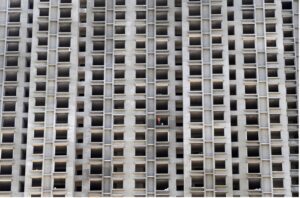
New housing in Xinjiang, China (From Hanlon 2019.)
However, much of the surveillance in Xinjiang is taking place through an even more intrusive process that relies on “people power” rather than technology. In 2013, the central government announced that 200,000 party cadres would be sent into about 9000 villages and communities, primarily in the rural south, where most of the Uyghur population lives. They sent five to seven person teams, including at least one Uyghur speaker, to live and work among the people of these villages and hamlets – inserting them into homes as so-called ‘relatives’ for three years. This was a $1 billion project of surveillance and social control on a scale unseen since the Cultural Revolution. Similar placements of “relatives” in Uyghur homes continues today throughout Xinjiang, as reported by a US Holocaust Memorial Museum study described in greater detail below.[74] These digital and human surveillance systems became the foundation of China’s policy for the erasure of Muslim culture and identity – a policy that, by 2017, was recognized as a genocide.
Genocide based on ethnicity and religion, eliminating collective memory and cultural identity.
“Governments in many parts of the world continue to target religious minorities using a host of methods, including torture, beatings, unlawful surveillance, and so-called re-education camps… NGOs like Campaign for Uyghurs and Uyghur Human Rights Project are documenting the genocide and crimes against humanity against predominately Muslim Uyghurs in Xinjiang, China.”
Secretary of State Anthony J. Blinken, May 15, 2023.[75]
During the 2019-2023 5-year MOU with China, U.S. and European governmental bodies and NGOs have repeatedly stated that China’s government policies against its Muslim minorities constituted genocide.[76] During this limited time frame, in Xinjiang province alone, the PRC has imprisoned a million innocent people, subjected tens of thousands to torture, forced sterilization, and forced labor, and taken nearly a million infants and children away from parents and relatives into state-run orphanages, where they are given new names, indoctrinated in Chinese Communist Party doctrine and taught to speak exclusively Han Chinese language.[77]
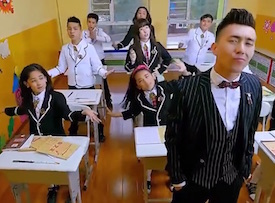
Screenshot of the music video for “Dear Teacher (Söyümlük Muellim)” by the Uyghur singer Ablajan Awut Ayup, from 2016. The song encourages children to study hard. He was detained in 2018 and sentenced to 11 years imprisonment on unclear charges in 2022. https://www.youtube.com/watch?v=yPmdkB8Ww3Y
A 2021 study by the Uyghur Human Rights Project details how over 300 noted intellectual and cultural producers, from folklore expert Dr. Rahile Dawut, former Xinjiang University President Tashpolat Teyip, Medical University President Halmurat Ghopur, poet Addujagir Jalaleddin, and pop singer Ablajan Ayup have all disappeared into the camps and prisons.[78] Editors of previously approved textbooks on Uyghur history have been given life sentences and “suspended” death sentences for “inciting ethnic hatred” and “fabricating separatist materials.”[79]
The State Department’s Office of International Religious Freedom reported in May 2021 that the whereabouts of “hundreds of prominent Uyghur intellectuals, religious scholars, cultural figures, doctors, journalists, artists, academics, and other professionals… remained unknown.”[80] The same report quotes CCP General Secretary Xi Jinping, stating that the government’s actions to Sinicize Islam were “totally correct and must carry on for a long time.”[81] Analysts believe this “cultural cleansing” is intended to deprive the Uyghur population of potential future leadership and to remove the custodians of cultural heritage from communities.
Religious leaders and teachers, even the very elderly, have been disappeared into the camps and many are known to have died there after severe punishment. Even before the last renewal of the China MOU, the State Department designated China as a “Country of Particular Concern” under the International Religious Freedom Act (IRFA) along with Burma, Iran, and North Korea, for having “engaged in or tolerated systematic, ongoing and egregious violations of religious freedom.” This is the most severe designation under the IRFA.
Forced abortions and sterilization.

Uyghurs and supporters demonstrate in Berlin for the human rights of persecuted Muslim minorities in China, following the July 2009 Ürümqi riots, Claudia Himmelreich, 10 July 2009, Creative Commons Attribution 2.0 Generic license.
The United States Holocaust Memorial Museum (USHMM) issued an unprecedented public report entitled, “To Make Us Slowly Disappear,” in November 2021. The report focused on crimes against humanity perpetrated against the Uyghur population in China.[82] Among these crimes, it identified “forced sterilization, sexual violence, enslavement, torture, forcible transfer, persecution, and imprisonment.”[83]
Limitation of births is considered a key element of genocide. Between 2017 and 2018, the birthrate across Xinjiang dropped by 48.74%, nearly half. In areas where the majority population is at least 90% Muslim, the birth rate dropped by 56.5% in the same years. The USHMM report states that the following year, 2019, government policies became even more oppressive; they were deliberately focused on reducing or eliminating Uyghur births:[84]
“In 2019, the Chinese government set in motion its Special Action Plan of the ‘Two Thorough Investigations’ of Illegal Births,” mandating counties to implement intrusive birth control measures, notably IUD placements and permanent sterilizations.[85] In the same year, the Xinjiang provincial government planned to either sterilize or place IUDs in at least 80 percent of women of child-bearing age in four prefectures where the Uyghur population is most concentrated.”[86]
Indoctrination camps for Uyghur children.
China’s expanded kindergarten renovations are a cover for indoctrinating children into exclusively Chinese language and culture[87] – including thousands of children taken from parents who have been sent to concentration camps. The $63 million the Chinese government says it has “invested” in preschool education in Xinjiang is really intended to eliminate Uyghur language and culture within a generation.
Although bilingual education is guaranteed in China’s constitution for its ethnic minorities, in Tibet, Mongolia, and among southern Chinese minority groups, President Xi’s policies have made pre-school and elementary education entirely in Chinese. Even children’s television and cartoons in parts of China where other languages were dominant, are now exclusively in Mandarin Chinese. Heavy sentences are imposed for teaching children about religion in minority regions. For example, in March 2023, a 62-year-old Uyghur mother was sentenced to 21 years in prison for sending her three children to religious school twenty years before.[88]
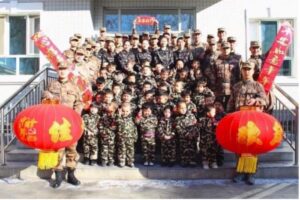
Chinese state propaganda photo of an “orphanage” for children confiscated from Uyghur concentration camp detainees, to deny them their culture and convert them into Chinese. (From Chinese social media).
Children are forcibly taken from parents and indoctrinated to replace their Uyghur customs, social relationships and language with Chinese language and Han customs. Children as young as toddlers – 14 months old – whose parents are detained or in prison or forced-labor factories are denied guardianships by grandparents and other relatives. They are deemed a “special needs category” to be put in “centralized care.”[89] Children at these schools are very poorly supplied, locked in, and relatives cannot visit.[90] The European Parliament has also confirmed that large numbers of Uyghur children are being taken from families. [91] The U.S. State Department estimated that 880,000 Uyghur children were held in boarding schools, some of which were noted as being “topped with barbed wire.”[92]
Another government program, called Pomegranate Flower,[93] was instituted in the 2021 to “pair up” children as young as infants and toddlers with Han Chinese families across the country, providing them with a new and better “family.”[94] The program’s official goal is to encourage people to “hug each other tightly like pomegranate seeds” to build a Chinese national identity that goes beyond ethnicity.[95] Children are assigned Chinese “families” who will call and visit them in the XUAR. There was no explanation given why children needed this family interaction – Uyghur analyst Ilshat Hassan told Radio Free Asia that in reality, their parents had either been detained in internment camps or sent elsewhere in China to perform forced labor.
State-sanctioned systematic rape and forced marriage.
Compelling testimony by Muslim women who were held in indoctrination camps and prisons and later escaped Xinjiang have revealed a camp and prison culture of pervasive, systemic rape and torture (most often combined) that is so pitiless and vile that it cannot be described here. Please refer to the many sources footnoted below.[96]
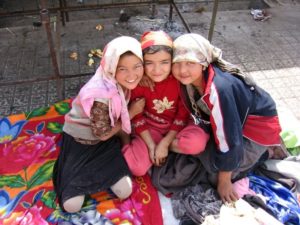
Uyghur girls at a Khotan Market, October 2005, Author Colegota, Wikimedia Commons
The USHMM reports that since 2017, approximately a million Han men have been sent into Uyghur households as “relatives” to live with and spy on suspect families, especially households where the male members have been interned.[97] Thousands of families are being destroyed by the policy of encouraging Han men to sleep in the same bed with wives of detainees. It is understood that sexual abuse cannot be refused or reported and Uyghurs in exile have described rampant rape and sexual abuse by the Chinese “relatives” of even minor girls. The shame and public humiliation these women and girls suffer is causing unimaginable heartbreak and destroying traditional Uyghur social relationships in villages across Xinjiang.[98]
The USHMM report also details how young, unmarried Uyghur women are coerced into forced marriages with newly arrived Han Chinese men.[99] If the young women refuse, they or their families may be sent to the internment camps.[100] The Chinese government also actively encourages Han men to come to Xinjiang seeking brides through promotional videos about the joys of marriage with compliant, obedient and beautiful Uyghur girls and by reserving places for children of mixed marriages at better schools and universities.[101]
VII. UYGHUR MONUMENTAL HERITAGE

Tomb of Lutpulla Mutellip, razed and transformed into a Happiness Park in Xinjiang.
The continuing destruction of Uyghur cultural monuments is a key part of China’s policy of eradicating Uyghur identity and traditions. The last seven years of ongoing destruction and damage of cultural monuments continues unabated. An Australian Strategic Policy Institute (ASPI) publication[102] cited by the U.S. State Department’s International Religious Freedom 2020 China-Xinjiang Country Report estimates that “approximately 16,000 mosques in the region (65 percent of the total) had been destroyed, damaged, or desecrated, and a further 30 percent of important Islamic sacred sites had been demolished.”[103] See also:[104]
It is important to point out that for ordinary Muslims in Xinjiang, it is a regular practice to visit shrines and the graves of holy men, a social duty similar to pilgrimages and visits to shrines of Catholic saints in the West. It is also a regular social practice to visit the graves of relatives and ancestors in cemeteries and to pray there for them.
Occasionally, before bulldozing a cemetery, Chinese authorities have given notice that anyone wanting to collect their relatives’ bones have three days to exhume and take them away. More often, the cemeteries are simply smashed and the space is eventually repurposed.
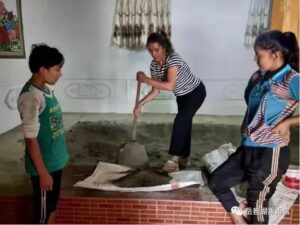
An Uyghur home where the supa is being destroyed. (From Chinese social media, captured by Timothy Grose; cf. Introvigne 2020)
For example, the cemetery of Sultanim in the Old City of Hotan, which dated to at least 960 AD, was turned into a parking lot in 2019,[105] and the tomb of the revered modern writer Lutpulla Mutellip was destroyed when thousands of Uyghur graves were dug up to create a so-called Happiness Park.[106]
The crackdown against Muslim tradition extends today into every Uyghur family home. Traditionally, ordinary private homes sometimes included a mihrab, a simple wall painting indicating the direction for prayer, which now must be destroyed. Even non-religious but traditional aspects of family living like the Uyghur heated floor space called a supa must be dug up and removed.[107] Korans and other religious books must be destroyed – it is illegal to teach your own children religion – and traditional textiles and prayer carpets can be seized and the householder arrested. There are bans on ordinary activities of daily life: saying prayers, giving traditional greetings, and fasting on Ramadan are all considered anti-social markers demonstrating ones’ opposition to the Chinese government. You can be jailed for refusing to drink alcohol or eat pork. All these traditional aspects of home life are considered a sign of mental sickness leading to terrorist or extremist tendencies.
VIII. MUSEUMS AND THE ERASURE OF HISTORY

Entrance of the Xinjiang Uyghur Autonomous Region Museum in Ürümqi, with a banner saying “Under the guidance of Xi Jinping’s ideology of socialism with Chinese characteristics for a new era, we strive to compose the Xinjiang chapter of the Chinese nation’s great rejuvenation of the Chinese dream.” Photo by Kubilayaxun, 26 August 2018, CCA-SA 4.0 International license.
The question arises as to how China deals with the “otherness” of minority cultures in its museums. While fine artworks from Tibet, Mongolia, and ancient Xinjiang are found in Chinese museums outside the minority regions,[108] the regional state museums in Xinjiang and Tibet also serve political purposes and carry a clear message of Han Chinese superiority. The Tibetan National Museum in Lhasa has a large collection of ancient and historic objects, not surprising
given the massive destruction and looting of monasteries and shrines in the 1950s-1970s. However, a major focus of the museum are displays about Tibetans extreme poverty and brutal exploitation by the Dalai Lama and other “feudal” oppressors and the benefits and influence of Han culture on the Tibetans. The museum has a central exhibition establishing China’s right to rule Tibet and displays the original 17-point agreement turning Tibet over to Chinese rule that the Dalai Lama was forced to sign in 1951, which he repudiated as soon as he escaped.
The objects and displays in the Urumchi Museum in Xinjiang include the Tarim Basin mummies (who are multi-ethnic Central Asians, not Chinese), a display of ancient objects in which Chinese rather than Central Asian styles predominate and displays of “traditional” Uyghur people emphasizing their nomadic and unsophisticated lifeways. The didactic misrepresents Xinjiang/Eastern Turkestan’s history as always being part of China.
Compare the dismissive attitudes of the PRC to the many hundreds of U.S., U.K. and European scholarly publications on ancient and historic Tibet and Eastern Turkestan/Xinjiang and the dozens of American museums with fine collections of Tibetan and ancient Central Asian art across the country, including Los Angeles County Museum of Art,[109] the Art Institute of Chicago, the Walters Art Museum, Newark Museum of Art, Rubin Museum of Art, and many others. These institutions serve not only the general public, bringing an uncensored perspective to exhibition and scholarship, but also honor the heritage of the 30,000 persons of Tibetan ancestry and over 10,000 Uyghurs who make their home in the U.S.
The Library of Congress holds one of the largest collections of Tibetan manuscripts in the West.[110] Tibet House US in New York City was founded at the request of the Dalai Lama, who welcomed the establishment of a long-term cultural institution “to ensure the survival of Tibetan civilization and culture” Its donors have gifted some 1500 objects that will be held until they can return to a free and secure Tibet.
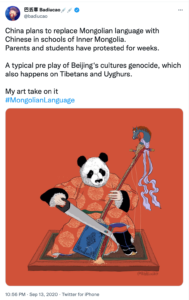
Artist Badiucao, image with Xi as panda killing Mongolian culture. Badiucao Twitter feed.
China’s domestic censorship and rewriting of history in its museums has spread into foreign cultural exchange. In November 2020, the Chateau des Ducs de Bretagne’s Musée d’Histoire de Nantes announced that the museum was making an ethical decision to postpone a long-planned exhibit on Genghis Khan, eliminating loaned objects from the PRC and replacing them with Mongol artifacts from French and other museums.[111]
In order to obtain loans from Chinese museums, China’s Bureau of Cultural Heritage instructed the Nantes museum that the name “Genghis Khan”, the words “Empire” and “Mongol” must be removed from the exhibition’s signage, didactic, maps and programming. The Beijing heritage office “applied a censorship to the initial project that includes… biased rewriting aimed at making Mongolian history and culture completely disappear for the benefit of a new national story,” a rewritten history casting the Mongol achievements as Han Chinese. Director Bertrand Guillet told the press, “We decided to stop this production in the name of the human, scientific and ethical values that we defend.” [112]
Such outspokenness is rare. European and American art museums’ collaborations with their Chinese counterparts as well as directly with the Chinese government are framed as a positive form of cultural exchange, fostering mutual understanding, but exiled Chinese artist Ai Wei Wei has accused foreign art museums that participate in exchanges of abetting China’s “crude censorship on ideology and free speech,” saying, “any state or organization, business or culture alike, involved with a state with such an extremely poor record on human rights, with divisive ideas about those most important values such as free speech, becomes a part of this power. If you do not question that power you become complicit with it…”[113]
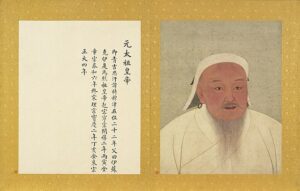
Emperor Taizu of Yuan, personal name Temujin, better known as Genghis Khan. Page from an album depicting several Yuan emperors (Yuandai di banshenxiang), now located in the National Palace Museum in Taipei, Paint and ink on silk.
Of course, American businesses that market popular culture want positive ties with China. It is not uncommon for American sports celebrities to take multi-million-dollar fees to play in China, and numerous popular films have been censored or had narratives reconfigured to suit the Chinese market, one of the more egregious examples being Disney’s Mulan, in which the heroine was originally fighting on behalf of a China that, at the time, was led by a Mongol Khan.[114]
As an economic, political, military, and cultural heavyweight, China cannot be ignored by museums and arts promoters in foreign countries. Some have also questioned whether the abhorrent politics espoused by the Chinese government are sufficient cause to threaten the Chinese people’s access to foreign arts and culture. Such arguments ignore the fact that China’s government severely restricts its citizens’ access to art, blocking any art or ideas critical of the government through its Great Firewall, and imprisons critical creators, their families, friends, and attorneys for the slightest satires.
Considering China’s blatant assaults on history and the rights of minorities, neither should U.S. museums and other institutions partner with Chinese government initiatives that trade the facts for the propaganda goals of a dictatorship, no matter how lucrative the rewards. Arts institutions have good reasons to hold themselves to a higher standard and not to accept censorship of their exhibitions or be complicit in the distortion of their narrative, whether at home or in Chinese territory. As stewards of history and of culture, maintaining these principles is essential.
IX. STEPS ALREADY TAKEN BY CONGRESS AND THE EXECUTIVE BRANCH
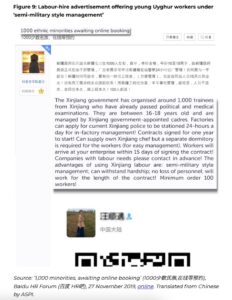
Uyghur Labor Hire advertisement, Nathan Ruser , Dr James Leibold , Kelsey Munro & Tilla Hoja, Australian Strategic Policy Institute (ASPI) publication, ‘Cultural erasure,’ 24 September 2020, https://www.aspi.org.au/report/cultural-erasure.
On January 19, 2021, then U.S. Secretary of State Michael Pompeo publicly announced his determination that since at least March 2017, the government of the People’s Republic of China has committed crimes against humanity and genocide against Uyghurs, who are predominantly Muslim, and members of other ethnic and religious minority groups in Xinjiang.[115]
On June 17, 2020, President Biden signed into law the Uyghur Human Rights Policy Act of 2020 authorizing the imposition of U.S. sanctions, including asset blocking and denial of visas, against Chinese officials responsible for the detention and persecution of Uyghurs and other Muslim minorities in Xinjiang.[116]
A 2020 US Department of Labor report, Against Their Will: The Situation in Xinjiang stated:
“Victim testimonies, news media, and think tanks report that factories, including for gloves, frequently engage in coercive recruitment; limit workers’ freedom of movement and communication; and subject workers to constant surveillance, retribution for religious beliefs, exclusion from community and social life, and isolation. Further, reports indicate little pay, mandatory Mandarin lessons, ideological indoctrination, and poor living conditions. In some instances, workers have been reported to be subject to torture. More broadly, according to varied estimates, at least 100,000 to hundreds of thousands of Uyghurs, ethnic Kazakhs, and other Muslim minorities are being subjected to forced labor in China following detention in re-education camps.”[117]
Congress and the President acted to block import of Chinese goods made by slave labor under the Uyghur Forced Labor Prevention Act. A forced labor prevention law explicitly responding to forced labor practices in Xinjiang[118] was signed by President Biden in December 2021.
The Uyghur Forced Labor Prevention Act is intended to prevent importation of goods mined, produced, or manufactured wholly or in part with forced labor in Xinjiang, China; it will also apply to goods made by forced labor – essentially slave labor – by other persecuted minorities, including Kazakhs, Kyrgyz, and Tibetans. An estimated million persons are held in concentration camps in Xinjiang. Following so-called ‘release’ from detention, at least 100,000 workers, many of whom are young women, have been taken from the camps and compelled to work long hours every day in factories in the XUAR and in other parts of China, where they are locked in fenced-in factories and dormitories under police supervision, forced to attend ideological training and Mandarin Chinese lessons after work hours, and forbidden to practice their religion or contact their families or children.[119]

Pomegranate Seed Night for Uyghur workers at forced labor factory. Australian Strategic Policy Institute, Policy ‘Uyghurs for Sale.’ March 2020.
In 2020, the Australian Strategic Policy Institute and the International Cyber Policy Centre released a report on their extensive analysis of Uyghur forced labor in supply chains for major international corporations, including Apple, BMW, Gap, Huawei, Nike, Samsung, Sony and Volkswagen.[120]
At a March 2023 Hearing on Preserving Tibet: Combatting Cultural Erasure, Forced Assimilation and Transnational Repression held at the Congressional-Executive Commission on China, Congressman Chris Smith and Senator Jeff Merkley set forth bi-partisan legislation responding to China’s abusive policies led by them and by Congressmen Jim McGovern and Michael McCaul and Senator Todd Young, among others. The bi-partisan Promoting a Resolution to the Tibet-China Conflict Act, H.R. 533/S. 138, will advance this Congress, as will legislation addressing the grave, well-documented violations of the human rights of minority peoples: the Uyghur Policy Act of 2023, H.R. 2766/S.1252. An important step to stop the Chinese government from executing young, healthy prisoners in order to take their organs for transplants is H.R. 1154, the Stop Forced Organ Harvesting Act of 2023, introduced by Congressman Chris Smith and Senator Tom Cotton, which passed the House in March 2023.
Congress and the Administration are responding to the horrific abuses in China. It is time for CPAC to do so as well.
X. CONCLUSION
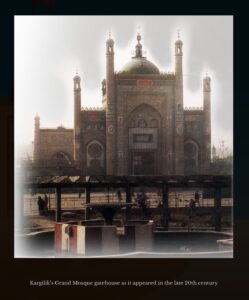
Kargalik Grand Mosque Gatehouse late 20th C, Cultural erasure, ASPI, 24 September 2020, https://www.aspi.org.au/report/cultural-erasure
China is not “protecting” the cultural heritage of millions of its citizens. It is destroying it. China is not preserving history, it is rewriting it to falsely portray once autonomous countries within its current borders as ‘forever Chinese.’ Renewing the MOU at this time would signal approval for China’s imposition of a single cultural norm and approval of its government’s vicious persecution of religious and cultural minorities. It is abundantly clear that the People’s Republic of China is in violation of the International Religious Freedom Act of 1998 (IRFA) as well as the UN Charter and UNESCO Convention.
There are important reasons for the U.S. government to maintain close, effective diplomatic relations with China. We must work with China because it is a major trade partner, despite its duplicitous claims that its supply lines for goods sent to the U.S. are not tainted by forced labor. We must engage with China in order to protect our own National Security interests, to counter China’s moves to control infrastructure in developing nations in Africa, Southeast Asia, South and Central Asia, to limit its nuclear superpower status, and to keep its aggressive militarization of the South China Sea and threats to Taiwan, Japan and South Korea within bounds.
But maintaining diplomatic relations does not require that we abandon fundamental U.S. principles or sign MOUs that ignore the plain language of the 1983 Cultural Property Implementation Act. China, the dominant global market for Chinese art and one of the most restrictive authoritarian governments in the world, does not need US assistance in restricting access to its cultural property.

Kargalik Grand Mosque Gatehouse, September 2018, Cultural erasure, ASPI, 24 September 2020, https://www.aspi.org.au/report/cultural-erasure.
We have shown that there are no legitimate reasons to renew the China MOU. In making public policy, the US government has often said that human rights are fundamental rights that should not be minimized or disregarded because they conflict with temporary political goals. For decades, historians and academics have pointed out the dangers of treating ‘culture’ as at the service of the state. The deliberate destruction of the culture of religious and ethnic minorities in China is a clear reminder that the lessons of the 20th century, in which totalitarian regimes defined ‘culture’ for the darkest of political purposes, should not be forgotten.
At the United Nations Human Rights Council’s 33rd Session of October 6, 2016, the People’s Republic of China adopted Resolution 33/20, Cultural Rights and the Protection of Cultural Heritage. It reads, in part:
“The Human Rights Council… Recalling the Universal Declaration of Human Rights, the Vienna Declaration and Programme of Action, the Declaration on the Right to Development and all relevant international human rights treaties, including the International Covenant on Economic, Social and Cultural Rights and the International Covenant on Civil and Political Rights, and reaffirming the human rights and fundamental freedoms enshrined therein… Recognizing further that the violation or abuse of the right of everyone to take part in cultural life, including the ability to access and enjoy cultural heritage, may threaten stability, social cohesion and cultural identity, and constitutes an aggravating factor in conflict and a major obstacle to dialogue, peace and reconciliation… Calls for the development of partnerships between competent national authorities and civil society, in particular grass-roots institutions, with the aim of enhancing the protection of cultural rights and promoting the right of everyone to participate in cultural life, including the ability to access and enjoy cultural heritage; … [and] Calls for the safety and security of cultural rights defenders involved in the protection of cultural heritage to be protected, including by investigating and, where appropriate, bringing to justice anyone alleged to have harmed them.” [121]
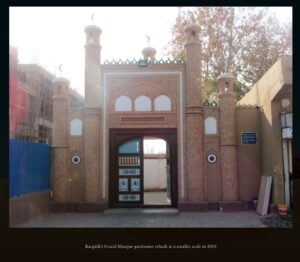
Kargalik Grand Mosque Gatehouse, rebuilt at tiny scale, 2019, Cultural erasure, ASPI, 24 September 2020, https://www.aspi.org.au
The Government of the Peoples Republic of China has obviously failed to adhere to the commitment it made to the United Nations to “enhance the protection of cultural rights and promote the right of everyone to participate in cultural life, including the ability to access and enjoy cultural heritage.” Its actions reflect its blatant hypocrisy.
We have far higher expectations that our government and its advisors will consider the issues, examine the facts, and honor our own laws. We urge you in the strongest terms to deny renewal of the MOU between the United State and the PRC under the Cultural Property Implementation Act.
Kate Fitz Gibbon, Executive Director, The Committee for Cultural Policy, Inc.
Elias Gerasoulis, Executive Director, Global Heritage Alliance, Inc.
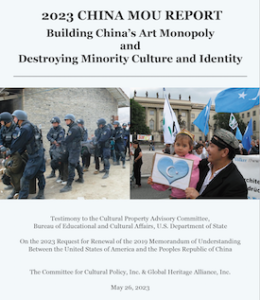 PDF Form 2023-05-25 China MOU Report Committee for Cultural Policy & Global Heritage Alliance
PDF Form 2023-05-25 China MOU Report Committee for Cultural Policy & Global Heritage Alliance
[1] The Committee for Cultural Policy, Inc. POB 4881, Santa Fe, NM 87502. www.culturalpropertynews.org, info@culturalpropertynews.org, 505-216-9369. Global Heritage Alliance, Inc., 5335 Wisconsin Ave., NW Ste 440, Washington, DC 20015, info@global-heritage.org, (202) 331.4209.
[2] U.S. Department of State press release, Spokesperson comments May 15, 2023, https://www.state.gov/senior-state-department-official-on-the-2022-report-on-international-religious-freedom/
[3] Xinjiang Political ‘Re-Education Camps’ Treat Uyghurs ‘Infected by Religious Extremism’: CCP Youth
League. RFA, 2018-08-08. https://www.rfa.org/english/news/uyghur/infected-08082018173807.html
[4] Proposal to extend The Memorandum of Understanding between the Government of the United States of America and the Government of the People’s Republic of China Concerning the Imposition of Import Restrictions on Categories of Archaeological Material From the Paleolithic Period Through the Tang Dynasty and Monumental Sculpture and Wall Art at least 250 Years Old, 88 FR 32264, 05/19/2023, https://www.federalregister.gov/documents/2023/05/19/2023-10769/proposal-to-extend-cultural-property-agreement-between-the-united-states-and-china.
[5] Nathan Ruser, Dr. James Liebold, Kelsey Munro,and Tilla Hoja, ‘Cultural erasure, Tracing the destruction of Uyghur and Islamic spaces in Xinjiang,’ Australian Strategic Policy Institute, 24 September 2020, https://www.aspi.org.au/report/cultural-erasure
[6] Xinjiang Political ‘Re-Education Camps’ Treat Uyghurs ‘Infected by Religious Extremism’: CCP Youth League, Radio Free Asia, 2018-08-08. https://www.rfa.org/english/news/uyghur/infected-08082018173807.html [Internal Chinese government instructions in lingo of “disease,” “malignant tumors,” and “eradication”]
[7] United States Department of State, Bureau of Democracy, Human Rights, and Labor, 2021 Country Reports on Human Rights Practices, China (Includes Hong Kong, Macau, and Tibet), 1, April 12, 2022, https://www.state.gov/wp-content/uploads/2022/03/3136152_CHINA-2021-HUMAN-RIGHTS-REPORT.pdf. This report details human and cultural rights abuses consistent with reports from the prior administration.
[8] 19 U.S.C. §§ 2601 et seq. Enacted as: “Title III of Public Law 97-446”, on January 12, 1983
[9] “Any State Party to this Convention whose cultural patrimony is in jeopardy from pillage of archaeological or ethnological materials may call upon other States Parties who are affected. The States Parties to this Convention undertake, in these circumstances, to participate in a concerted international effort to determine and to carry out the necessary concrete measures, including the control of exports and imports and international commerce in the specific materials concerned. Pending agreement each State concerned shall take provisional measures to the extent feasible to prevent irremediable injury to the cultural heritage of the requesting State.” Convention on the Means of Prohibiting and Preventing the Illicit Import, Export, and Transfer of Ownership of Cultural Property of 1970, Art. 9 (UNESCO).
[10] 19 U.S.C. § 2602(d), 19 U.S.C. § 2602(a)(1)(A)–(D).
[11] 19 U.S.C. § 2602(a)(1)(A)–(D).
[12] Francesca Aton, ‘Two Stolen Artifacts, From the Collection of a Met Board Member, Were Returned to China,’ ArtNews, May 11, 2023, https://www.artnews.com/art-news/news/metropolitan-museum-of-art-new-york-china-looted-relics-1234667531/.
[13] Magnus Fiskesjo, ‘Bulldozing Culture: China’s Systematic Destruction of Uyghur Heritage Reveals Genocidal Intent.’ Cultural Property News, June 23, 2021. https://culturalpropertynews.org/bulldozing-culture-chinas-systematic-destruction-ofuyghur-heritage-reveals-genocidal-intent/
[14] Id.
[15] U.S. Department of State, Office of International Religious Freedom, ‘TIBET 2022 International Religious Freedom Report,’ May 2023, https://www.state.gov/wp-content/uploads/2023/05/441219-TIBET-2022-INTERNATIONAL-RELIGIOUS-FREEDOM-REPORT.pdf
[16] Id.
[17] Id.
[18] Kate Fitz Gibbon, ‘A Culture Destroyed: China Expunges Uyghur Identity. China Interns A Million or More Muslims in ‘Re-education’ Camps.’ August 27, 2018. https://culturalpropertynews.org/a-culture-destroyed-china-expunges-uyghur-identity/
[19] China’s law recognizes private ownership of cultural property. In China, citizens may lawfully inherit or accept cultural relics as gifts, purchase cultural relics from stores, purchase cultural relics from auction houses, or mutually exchange cultural relics owned by individual citizens. Global Art and Heritage Law Series – China, Committee for Cultural Policy in collaboration with Thomson-Reuters Foundation, April 2020, 37, https://culturalpropertynews.org/pdf/CCP-Global-Art-and-Heritage-Law-Series-China.pdf.
[20] Id. at 40.
[21] Keija Wu, TEFAF Art Market Report 2020, https://www.tefaf.com/
[22] Id.
[23] Testimony of James Lally to the Cultural Property Advisory Committee on the application of China for a Cultural Property Agreement with the United States, April 22, 2013.
[24] http://www.unesco.org/culture/natlaws/media/pdf/egypt/egypt_ba_china_10_arenorof
[25] Agreement between the Federal Council of the Swiss Confederation and the Government of the People’s Republic of China on illicit Import and Export and Repatriation of Cultural Property (entered into force on January 8, 2014), http://www.unesco.org/culture/natlaws/media/pdf/switzerland/sw_ba_china_13_entof
[26] 19 U.S.C. § 2602 (a)(l)(C)(ii)
[27] 19 U.S.C. § 2602(a)(1) (C)(ii)
[28] Testimony of James J. Lally to CPAC, April 22, 2013. Recent investigations by Peter K. Topma confirmed that it continues to be impossible to obtain paperwork necessary for U.S. import.
[29] Global Art and Heritage Law Series – China, Committee for Cultural Policy in collaboration with Thomson-Reuters Foundation, April 2020, p 40, https://culturalpropertynews.org/pdf/CCP-Global-Art-and-Heritage-Law-Series-China.pdf . “Further, the period for re-export of repatriated artworks was reduced from two years to six months following the date of purchase. A letter written on behalf of the International Association of Professional Numismatists (“IAPN”) to the U.S. Department of State’s Cultural Property Advisory Committee cites an article from The Economist, published on November 26, 2009. The article states that “the authorities have been quietly tightening up on the re-export of repatriated artworks. Chinese buyers used to be able to re-export their treasures for up to two years after they had bought them. That period of grace has now been reduced to six months.”
[30] 19 U.S.C. § 2602(a)(1)(D).
[31] Global Chinese Art Auction Market Report 2016 at 12. Between 2009 and 2011 auction sales of arts and antiques overseas had also expanded by 278%.
[32] Extensive scholarship by Western and Chinese art historians and the long history of collecting in the West, Hong Kong and Japan enabled the development of a stable market in antiquities and antiques inside China. In comparison, the modern market in contemporary works by Chinese artists fluctuates dramatically with fashion.
[33] Keija Wu, TEFAF Art Market Report 2020, https://www.tefaf.com/
[34] Deborah Lehr, China’s Art Market is Booming—Just Not for Foreigners, Huffington Post, Mar. 1. 2017, https://www.huffingtonpost.com/entry/chinas-art-market-is-booming-but-not-for-foreigners_us_58b6fb0de4b0563cd36f6399.
[35] Keija Wu, TEFAF Art Market Report 2020, https://www.tefaf.com/
[36] Census and Statistic Department, the Government of the Hong Kong Special Administrative Region, Hong Kong Monthly Digest of Statistics: Trade between Hong Kong and the Mainland of China, June 2016, http://www.statistics.gov.hk/pub/B71606FC2016XXXXB0100.pdf.
[37] Global Chinese Art Auction Market Report 2016 at 18.
[38] Global Art and Heritage Law Series – China, Committee for Cultural Policy in collaboration with Thomson-Reuters Foundation, April 2020, p 40.
[39] Keija Wu, TEFAF Art Market Report 2020, https://www.tefaf.com/
[40] A notable case centered on 44 lots of letters by modern Chinese poets, calligraphers, artists, and scholars in an auction at Canton Treasure in September 2020 in Guangzhou city. See: Shana Wu, ‘China cracks down on sale of stolen antiquities and archives,’ The Art Newspaper, 8 April 2022,, https://www.theartnewspaper.com/2022/04/08/china-cracks-down-on-sale-of-stolen-antiquities
[41] Id.
[42] 19 U.S.C. 2607, See Cultural Property Implementation Act, SEC. 308. “STOLEN CULTURAL PROPERTY. No article of cultural property documented as appertaining to the inventory of a museum or religious or secular public monument or similar institution in any State Party which is stolen from such institution after the effective date of this title, or after the date of entry into force of the Convention for the State Party, whichever date is later, may be imported into the United States.”
[43] The National Stolen Property Act of 1934 (NSPA) (18 U.S.C. §§ 2314 et seq.) prohibits the transportation in interstate or foreign commerce of any goods with a value of $5,000 or more with the knowledge that they were illegally obtained and prohibits the “fencing” of such goods.” National Stolen Property Act – Summary of Law, https://coast.noaa.gov/data/Documents/OceanLawSearch/Summary%20of%20Law%20-%20National%20Stolen%20Property%20Act.pdf
[44] U.S. Secretary of State Mike Pompeo, on June 17, 2020, announcing the U.S. State Department, International Religious Freedom Report for 2020, June 17, 2020.
[45] ‘Updated: Bomb Destroys Persecuted Church,’ ChinaAid, January 10, 2018, https://chinaaid.org/bomb-destroys-persecuted-church/
[46] Ian Johnson, ‘Chinese Christians Resist Government Plan to Remove Crosses,’ New York Times, August 10, 2015, https://www.nytimes.com/2015/08/11/world/asia/chinese-christians-resist-government-plan-to-remove-crosses.html
[47] Ian Johnson, ‘Decapitated Churches in China’s Christian Heartland,’ New York Times, May 21, 2016, https://www.nytimes.com/2016/05/22/world/asia/china-christians-zhejiang.html.
[48] In 2021, the UK Parliament voted unanimously to declare that China’s government was committing genocide and crimes against humanity in Xinjiang. https://ipac.global/uk-parliament-unanimously-declares-the-chinese-government-is-committing-a-genocide-against-uyghurs-in-historic-first/
[49] United States Holocaust Memorial Museum (USHMM), “To Make Us Slowly Disappear,” https://www.ushmm.org/genocide-prevention/reports-and-resources/the-chinese-governments-assault-on-the-uyghurs.
[50] Pico Iyer, ‘China’s Buddha Complex,’ Snow Lion Newsletter, Winter 1996, Shambala Publications, https://www.shambhala.com/snowlion_articles/tibet_china_conflict/
[51] Ryan Cimmino, ‘Threat from Tibet? Systematic Repression of Tibetan Buddhism in China,’ Harvard International Review, Fall 2018, https://hir.harvard.edu/repression-tibetan-buddhism-china/.
[52] The Committee on Economic, Social and Cultural Rights (CESCR) is the body of 18 independent experts that monitors implementation of the International Covenant on Economic, Social and Cultural Rights by its State parties.
[53] Committee on Economic, Social and Cultural Rights, Concluding Observations, 6 March 2023: https://tbinternet.ohchr.org/_layouts/15/treatybodyexternal/Download.aspx?symbolno=E%2FC.12%2FCHN%2FCO%2F3&Lang=en
[54] Senate Resolution 429 – Commemorating The 59th Anniversary of Tibet’s 1959 Uprising As “Tibetan Rights Day,” And Expressing Support For The Human Rights And Religious Freedom Of The Tibetan People…; Congressional Record Vol. 164, No. 41, https://www.congress.gov/115/crec/2018/03/08/CREC-2018-03-08-pt1-PgS1583-2.pdf (last visited 3/26/23)
[55] “Chinese statistics estimate 87,000 Tibetans were killed, arrested, or deported to labor camps during the suppression of the 1959 uprising, which also forced the Dalai Lama and tens of thousands of other Tibetans to flee into exile…” Id.
[56] Id.
[57] State Religious Affairs Bureau Order No. 5, Measures on the Management of the Reincarnation of Living Buddhas in Tibetan Buddhism, passed during a conference of the State Administration for Religious Affairs, 13 July 2007. The Regulations are extremely detailed and require various levels of government approval for being a reincarnate soul or else they are illegal and invalid. “It is an important move to institutionalize management on reincarnation of living Buddhas. The selection of reincarnates must preserve national unity and solidarity of all ethnic groups and the selection process cannot be influenced by any group or individual from outside the country.” Thus, the Dalai Lama and other Tibetans outside Tibet are forbidden involvement. https://en.wikipedia.org/wiki/State_Religious_Affairs_Bureau_Order_No._5.
[58] USCIRF Report on International Religious Freedom, 2017. https://www.state.gov/reports/2017-report-on-international-religious-freedom/
[59] Hannah Ellis Petersen, Tibet and China clash over next reincarnation of the Dalai Lama, The Guardian, 31 July 2021, https://www.theguardian.com/world/2021/jul/31/tibet-and-china-clash-over-next-reincarnation-of-the-dalai-lama
[60] 20 years later, PRC officials stated that the kidnapped Gendun Choekyi Nyima, identified by the Dalai Lama as the reincarnated Panchen Lama, was “growing up healthily” and “did not want to be disturbed.” ‘China says Panchen Lama ‘living a normal life’ 20 years after disappearance,’ The Guardian, 6 September 2015, https://www.theguardian.com/world/2015/sep/06/china-says-panchen-lama-living-a-normal-life-20-years-after-disappearance.
[61] Within days of the kidnapping, the government named another child, Gyaltsen Norbu, a Tibetan boy and the son of two Communist Party members, as the Panchen Lama. In a rare interview in 2021, Gyaltsen Norbu stated that Tibetan Buddhism must “adapt to a socialist society with Chinese characteristics and move towards sinicisation” for the “unification of the motherland, promoting national unity, and promoting social stability in order to have a bright future”. Sutirtho Patranobis, Hindustan Times, March 11, 2021, https://www.hindustantimes.com/world-news/panchen-lama-says-buddhism-in-tibet-will-be-sinicised-adopt-socialist-traits-101615439553367.html.
[62] Congressional-Executive Commission on China, “Chinese Government-Appointed Panchen Makes First Visit to Tibetan Areas of Sichuan Province,” July 7, 2005, https://www.cecc.gov/publications/commission-analysis/chinese-government-appointed-panchen-makes-first-visit-to-tibetan.
[63] Free Tibet, Desecration in Drago County: Destruction of Tibetan Religious Heritage, Arbitrary Detentions and Torture, January 2023, https://freetibet.org/wp-content/uploads/2023/01/Drago-County.pdf.
[64] Id.
[65] Sangyal Kunchok and Lobsang Gelek, ‘Tibetan monks, local residents forced to watch destruction of sacred statue,’ Radio Free Asia, January 1, 2022, https://www.rfa.org/english/news/tibet/forced-01042022161122.html and Sangyal Kunchok, ‘County chief who oversaw demolition of Tibetan Buddhist sites moved to new position,’ Radio Free Asia, April 11, 2023, https://www.rfa.org/english/news/tibet/wang-dongsheng-04112023170559.html.
[66] U.S. Department of State, Office of International Religious Freedom, ‘TIBET 2022 International Religious Freedom Report,’ May 2023, https://www.state.gov/wp-content/uploads/2023/05/441219-TIBET-2022-INTERNATIONAL-RELIGIOUS-FREEDOM-REPORT.pdf
[67] For example, “Radio Free Asia (RFA) reported that on August 24, authorities in Serthar County, Kardze (Ganzi) TAP, Sichuan Province, arrested five Tibetans for publicly stacking Buddhist mani stones, performing sangsol (an incense offering ceremony), and praying. Two sources told RFA that police beat the five individuals – Chugdar, Ghalo, Tsedo, Bhamo, and Kori – and Chugdar subsequently died of his injuries while in custody. The four others remained in detention at year’s end.” The U.S. State Department’s 2022 Report on International Religious Freedom: China—Tibet, 9, https://www.state.gov/wp-content/uploads/2023/05/441219-TIBET-2022-INTERNATIONAL-RELIGIOUS-FREEDOM-REPORT.pdf
[68] U.S. Department of the Treasury, press release, Treasury Sanctions over 40 Individuals and Entities over Nine Countries Connected to Corruption and Human Rights Abuse,’ December 9, 2022, https://home.treasury.gov/news/press-releases/jy1155. During Zhang’s tenure, the TPSB engaged in serious human rights abuse, including at TPSB-run detention centers that were involved in the torture, physical abuse, and killings of prisoners, including those arrested on religious and political grounds, arbitrary arrests, persecution of religious and political freedoms, and mass detentions.
[69] Id.
[70] Author Kubilayaxun, 26 August 2018, Creative Commons Attribution-Share Alike 4.0 International license.
[71] Joshua Hammer, ‘Demolishing Kashgar’s History,’ Smithsonian Magazine, March 2010, https://www.smithsonianmag.com/history/demolishing-kashgars-history-7324895/.
[72] Kate Fitz Gibbon, The Security State and Destruction of Uyghur Culture in Xinjiang
The Chinese government’s campaign to eradicate identity, religion, and culture. Cultural Property News, May 29, 2019, https://culturalpropertynews.org/the-security-state-and-destruction-of-uyghur-culture-in-xinjiang/
[73] Id.
[74] To Make Us Slowly Disappear, United States Holocaust Memorial Museum, Simon-Skjodt Center for the Prevention of Genocide, November 2021, https://www.ushmm.org/m/pdfs/November_2021_Uyghur_Report.pdf.
[75] Secretary of State Anthony J. Blinken, announcing the U.S. State Department’s 2022 Report on International Religious Freedom, May 15, 2023.
[76] In 2021, the UK Parliament voted unanimously to declare that China’s government was committing genocide and crimes against humanity in Xinjiang. https://ipac.global/uk-parliament-unanimously-declares-the-chinese-government-is-committing-a-genocide-against-uyghurs-in-historic-first/
[77] The United States Holocaust Memorial Museum’s Simon-Skjodt Center for the Prevention of Genocide “seeks to do for victims of genocide today what was not done for the Jews of Europe.” The organization believes that the Holocaust was preventable, and that future genocides can be prevented with bipartisan commitment among policy makers to prevent and respond to genocide and crimes against humanity. To that purpose the Center engages in “extensive research and analysis, education, and public and governmental outreach.” United States Holocaust Memorial Museum (USHMM), “To Make Us Slowly Disappear,” https://www.ushmm.org/genocide-prevention/reports-and-resources/the-chinese-governments-assault-on-the-uyghurs.
[78] Abdullah Qazanchi, contributions by Abduweli Ayup, ‘The Disappearance of Uyghur Intellectual and Cultural Elites: A New Form of Eliticide,’ Uyghur Human Rights Project, December 8, 2021, https://uhrp.org/report/the-disappearance-of-uyghur-intellectual-and-cultural-elites-a-new-form-of-eliticide/
[79] Id. at 15. “Former Deputy Secretary of the Xinjiang Education and Work Committee Sattar Sawut received a two-year suspended death sentence, while Alimjan Memtimin (Deputy Director General of the Xinjiang Education Department), Tahir Nasir (former president of the Education Publishing House), and other editors were given life sentences.”
[80] United States Department of State, Office of International Religious Freedom, 2020 Report on International Religious Freedom: China—Xinjiang, Executive Summary, 85, 2020, https://www.state.gov/wp-content/uploads/2021/05/240282-CHINA-INCLUDES-TIBET-XINJIANG-HONG-KONG-AND-MACAU-2020-INTERNATIONAL-RELIGIOUS-FREEDOM-REPORT.pdf (last visited 3/26/23).
[81] Id.
[82] To Make Us Slowly Disappear, United States Holocaust Memorial Museum, Simon-Skjodt Center for the Prevention of Genocide, November 2021, https://www.ushmm.org/m/pdfs/November_2021_Uyghur_Report.pdf.
[83] Id. at 2.
[84] Id. at 10, see also fn. 4, Adrian Zenz, “Sterilizations, IUDs, and Mandatory Birth Control: The CCP’s Campaign to Suppress Uyghur Birth Rates in Xinjiang,” Jamestown Foundation, March 17, 2021, 3, https://jamestown.org/product/sterilizations-iuds-and-mandatory-birth-control-the-ccps-campaign-to-suppress-uyghur-birthrates-in-xinjiang/.
[85] Id. at 26, See also fn. 121: Zenz, “Sterilizations, IUDs, and Coercive Birth,” sections 2.1.–2.3
[86] Ibid. 2-3, 12.
[87] Mihray Abdilim, Uyghurs see assimilation as China touts investment in Xinjiang preschools, Radio Free Asia, December 12, 2021, https://www.rfa.org/english/news/uyghur/preschools-investment-12212021191412.html.
[88] Shohret Hoshur, ‘Uyghur woman serving 21 years in jail for sending children to religious school,’ Ayshemhan Abdulla is one of scores of Uyghurs punished by Chinese authorities for the ‘crime.’ Radio Free Asia, 3/1/2023, https://www.rfa.org/english/news/uyghur/ayshemhan-abdullah-0301202311043.html.
[89] In one township, over 400 minors had both parents in some form of internment, and many more a single parent. Many children are reportedly kept in appalling conditions. See ‘Break Their Roots: Evidence of China’s Parent-Child Separation Campaign in Xinjiang,’ Journal of Political Risk, Vol. 7, No. 7, July 2019, https://www.jpolrisk.com/break-their-roots-evidence-for-chinas-parent-child-separation-campaign-in-xinjiang/
[90] Ibid., 1
[91] European Parliament, ‘Resolution on forced labour and the situation of the Uyghurs in the Xinjiang Uyghur Autonomous Region,’ 2020/2913 (RSP), Strasbourg: Legislative Observatory, 2020. para D, https://oeil.secure.europarl.europa.eu/oeil/popups/ficheprocedure.do?lang=en&reference=2020/2913(RSP)
[92] See also, U.S. Department of State, China 2021 Human Rights Report, 75, “The detention of an estimated one million or more Uyghurs, ethnic Kazakhs, Kyrgyz, and other Muslims in Xinjiang left many children without caregivers. While many of these children had relatives willing to care for them, the government placed the children of detainees in orphanages, state-run boarding schools, or “child welfare guidance centers,” where they were forcibly indoctrinated with CCP ideology and forced to learn Mandarin Chinese, reject their religious and cultural beliefs, and answer questions regarding their parents’ religious beliefs and practices.” Also, “In Hotan some boarding schools were topped with barbed wire,” https://www.state.gov/wp-content/uploads/2022/03/3136152_CHINA-2021-HUMAN-RIGHTS-REPORT.pdf
[93] Gulchehra Hoja, ‘Chinese government targets Uyghur children with ‘pomegranate flower’ policy,’ Radio Free Asia, October 10, 2021, https://www.rfa.org/english/news/uyghur/pomegranate-flower-program-10212021092622.html.
[94] Uyghur Human Rights Project, ‘Coerced Kinship: The Pomegranate Flower Plan and the Forced Assimilation of Uyghur Children,’ Uyghur Human Rights Project, January 27, 2022, https://uhrp.org/report/coerced-kinship-the-pomegranate-flower-plan-and-the-forced-assimilation-of-uyghur-children/
[95] Kang Haoyan, “南疆小村开出36对’石榴花’” [36 pairs of ‘pomegranate flowers’ have bloomed in a small village in southern Xinjiang], Xinjiang Daily, September 24, 2021 http://news.ts.cn/system/2021/09/24/036701428.shtml (archived at https://archive.ph/vzonB).
[96] See, for example:
1. Matthew Hill, David Campanale and Joel Gunter, ‘Their goal is to destroy everyone’: Uighur camp detainees allege systematic rape,’ BBC News, 2 February 2021, https://www.bbc.com/news/world-asia-china-55794071;
2. ‘A Million People Are Jailed at China’s Gulags. I Managed to Escape. Here’s What Really Goes on
- Rape, torture and human experiments.’ Sayragul Sauytbay offers firsthand testimony from a Xinjiang ‘reeducation’ camp. Haaretz, Oct 17, 2019. https://www.haaretz.com/world-news/2019-10-17/ty-article-magazine/.premium/a-million-people-are-jailed-at-chinas-gulags-i-escaped-heres-what-goes-on-inside/0000017f-e216-d804-ad7f-f3fe73670000 news/.premium.MAGAZINE-a-million-people-are-jailed-at-china-s-gulags-i-escaped-here-swhat-goes-on-inside-1.7994216;
- Ruth Ingram, ‘Raped, Tortured, Humiliated: The Uyghur Tribunal Hears 24 Witnesses.’ One witness testified that she and 100 other inmates were forced to watch prison guards rape a young girl in front of them. Bitter Winter, 06/09/2021. https://bitterwinter.org/raped-tortured-humiliated-the-uyghur-tribunal-hears-24-witnesses/;
- Benedict Rogers, ‘A Tribunal Investigates China’s Genocide Against the Uyghurs.’ The London-based panel found that torture, sexual violence, persecution and other crimes are proven. WSJ, Dec. 12, 2021, 4:38 pm ET. https://www.wsj.com/articles/tribunal-investigates-china-uyghur-genocidecrimes-against-humanity-rape-torture-beijing-extermination-11639339993;
- Cate Cadell, ‘’Inferior’ women: China counters Uighur criticism with explicit PR attacks.’ Reuters, March 1, 2021, 1:08 AM. Updated. https://www.reuters.com/article/us-chinaxinjiang/inferior-women-china-counters-uighur-criticism-with-explicit-pr-attacksidUSKCN2AT1BA;
- ‘Allegations of shackled students and gang rape inside China’s detention camps.’ CNN, Feb. 19, 2021. https://edition.cnn.com/2021/02/18/asia/china-xinjiang-teacher-abuse-allegations-intl-hnkdst/
- html;
- ‘Claims of rape and torture of Uighur women in China provoke global condemnation’, BBC News, Feb 4, 2021. https://www.youtube.com/watch?v=hh8QOh1aXRM&feature=youtu.be;
- Kevin Freking and Ellen Knickmeyer, ‘House China panel turns focus to plight of Uyghurs.’ AP, 24 March, 2023. https://apnews.com/article/china-uyghur-muslimsxinjiang-region-833fb8f337b3a87fcdf0b760bb3e7066, “Two women who experienced life in Chinese “reeducation” camps for Uyghurs told lawmakers Thursday of lives under imprisonment and surveillance, rape and torture as a special House committee focused on countering China shined a light on human rights abuses in the country.” (Qelbinur Sidik; Gulbahar Haitiwaji);
- Jason Morgan, ‘Death, Rape, Torture of the Uyghurs: The Daily Reality of Abuse in China.’ As victims of Beijing’s ethnic cleansing shared their experiences at a New York conference, it became impossible to see the Uyghur genocide as a distant crisis. Japan Forward, October 1, 2022. https://japan-forward.com/bookmark-death-rape-torture-of-theuyghurs- the-daily-reality-of-abuse-in-china/
[97] ‘Male Chinese ‘Relatives” Assigned to Uyghur Homes Co-Sleep with Female ‘Hosts’, Radio Free Asia, October 31, 2019, https://www.rfa.org/english/news/uyghur/cosleeping-10312019160528.html.
[98] ‘This is mass rape’: Uighur activist condemns program said to pay Chinese men to sleep with Uighur women to promote ‘ethnic unity’, Business Insider, December 24, 2019, https://www.insider.com/uighur-activists-mass-rape-chinese-men-xinjiang-2019-12
[99] USHMM, “To Make Us Slowly Disappear,” p 10, 40.
[100] Leigh Hartman, ‘China coerces Uyghur women into unwanted marriages,’ Share America, September 24, 2019, https://share.america.gov/china-coerces-uyghur-women-into-unwanted-marriages/
[101] Asim Kargarian, ‘China Video Ad Calls for 100 Uighur Women to ‘Urgently’ Marry Han Men,’ VOA, August 21, 2020, https://www.voanews.com/a/east-asia-pacific_voa-news-china_china-video-ad-calls-100-uighur-women-urgently-marry-han-men/6194806.html
[102] Australian Strategic Policy Institute (ASPI), ‘Cultural destruction and detention facilities in Xinjiang,’
https://www.aspi.org.au/news/cultural-destruction-and-detention-facilities-xinjiang, and also Kelsey Munro, Xinjiang Data Project website launch, September 25, 2020, https://www.aspi.org.au/news/xinjiang-data-project-website-launch.
[103] United States Department of State, Office of International Religious Freedom, 2020 Report on International Religious Freedom: China—Xinjiang, Executive Summary, 85, 2020, https://www.state.gov/wp-content/uploads/2021/05/240282-CHINA-INCLUDES-TIBET-XINJIANG-HONG-KONG-AND-MACAU-2020-INTERNATIONAL-RELIGIOUS-FREEDOM-REPORT.pdf
[104] Australian Strategic Policy Institute (ASPI), Cultural destruction and detention facilities in Xinjiang, https://www.aspi.org.au/news/cultural-destruction-and-detention-facilities-xinjiang, see also Kelsey Munro, Xinjiang Data Project website launch, September 25, 2020, https://www.aspi.org.au/news/xinjiang-data-project-website-launch.
[105] Satellite images reveal China is destroying Muslim graveyards where generations of Uighur families are buried and replacing them with car parks and playgrounds ‘to eradicate the ethnic group’s identity’, Daily Mail, 9 October 2019, https://www.dailymail.co.uk/news/article-7553127/Even-death-Uighurs-feel-long-reach-Chinese-state.html
[106] Id.
[107] Magnus Fiskesjo, ‘Bulldozing Culture: China’s Systematic Destruction of Uyghur Heritage Reveals Genocidal Intent.’ Cultural Property News, June 23, 2021. https://culturalpropertynews.org/bulldozing-culture-chinas-systematic-destruction-ofuyghur-heritage-reveals-genocidal-intent/
[108] An unusual example is the Zhiguan Museum of Fine Art is located in what was previously the Xian-Liang Temple in Beijing.
[109] The author of this report was present at a meeting at LACMA in the early 1980s where the Dalai Lama thanked U.S. private collectors and museums for preserving Tibetan culture in exile.
[110] The Buddhist Digital Resource Center of the Tibetan Buddhist Resource Center is based in the USA but working in China, Mongolia, Cambodia and elsewhere in Asia houses the largest collection of Buddhist texts in the world. It is engaged with the collection of 12,000 Buddhist texts donated by American E. Gene Smith (who acquired thousands of Tibetan texts as a field officer for the Library of Congress in Delhi) to the Southwest University for Nationalities (SWUN) in Chengdu, China. See Reclaiming Tibetan Culture in the Digital Age, Cultural Property News, July 17, 2020, https://culturalpropertynews.org/reclaiming-tibetan-culture-in-the-digital-age/
[111] The 13th century warrior Genghis Khan founded the largest contiguous empire in world history. In their brutal beginnings, Genghis Khan’s Mongol troops joined with Turkic warriors to conquer all of China, Central Asia, much of the Middle East, Eastern Europe, and large swaths of what would become Russia. In China, Genghis’ descendant Kublai Khan created the Yuan Dynasty, which maintained control of China for nearly one hundred years, until 1368. The ruthless Mongol steppe warriors were later renowned for their sophisticated diplomacy, patronage of the arts and sciences, and religious tolerance. One of the great achievements of Genghis Khan and his descendants was the creation of the political, trade and administrative system linking much of the Mongol kingdoms known as the Pax Mongolica. See: ‘Gengis Khan, Comment les Mongols ont changé le monde,’ Chateau des Ducs de Bretagne’s Musée d’Histoire de Nantes, now opening October 2023, https://www.chateaunantes.fr/expositions/gengis-khan/.
[112] Kate Fitz Gibbon, ‘Forget History. There is no Genghis Khan,’ Cultural Property News, https://culturalpropertynews.org/forget-history-there-is-no-genghis-khan/.
[113] Christina Ruiz, Ai Wei Wei, interview, ‘If you do not question Chinese power, you are complicit with it – that goes for arts organizations too,’ The Art Newspaper, 1 September 2020, https://www.theartnewspaper.com/2020/09/01/ai-weiwei-if-you-do-not-question-chinese-power-you-are-complicit-with-itthat-goes-for-art-organisations-too
[114] In Disney’s adaptation of Mulan (2020), Mulan fights alongside an ethnically Chinese army to defend the Han Emperor from merciless (and Muslim-coded) invaders. The invading army hails from a geographic area which overlaps with modern Xinjiang. The film was widely criticized outside China for its promulgation of Chinese government propaganda, for its lead actress’s endorsement of police brutality in Hong Kong, and for the credits thanking the government publicity department of Xinjiang, where scenes from the movie were actually filmed. The fact was largely forgotten that in the original story – on which both this film and Disney’s 1998 animated version were based – Mulan is fighting on behalf of a Mongol Khan. Disney was embarrassed but the bottom line is that China is one of Hollywood’s biggest markets.
[115] Determination of the Secretary of State on Atrocities in Xinjiang, Press Statement, Michael R. Pompeo, Secretary of State, January 19, 2021, https://2017-2021.state.gov/determination-of-the-secretary-of-state-on-atrocities-in-xinjiang/index.html
[116] “In July, the U.S. government imposed sanctions on four Chinese leaders and additional PRC entities pursuant to the Global Magnitsky Human Rights Accountability Act. During the year, the U.S. government added 20 PRC entities to the Department of Commerce’s Entity List that were implicated in human rights abuses in Xinjiang.” International Religious Freedom Report for 2020, U.S. Department of State, Office of International Religious Freedom, China, p3.
[117] US Department of Labor, Against Their Will: The Situation in Xinjiang, Washington, DC: Bureau of International Labor Affairs, 2020, https://www.dol.gov/agencies/ilab/against-their-will-the-situation-in-xinjiang
[118] H.R.6256 – To ensure that goods made with forced labor in the Xinjiang Uyghur Autonomous Region of the People’s Republic of China do not enter the United States market, and for other purposes, Public Law No. 117-78 (12/23/2021), https://www.congress.gov/bill/117th-congress/house-bill/6256
[119] Vicky Xiuzhong Xu, Danielle Cave, Dr. James Leibold, Kelsey Munro, Nathan Ruser, “Uyghurs for Sale, re-education, forced labour and surveillance beyond Xinjiang, Policy Brief, Report No. 26/2020, Australian Strategic Policy Institute (ASPI), March 1, 2020, https://www.aspi.org.au/report/uyghurs-sale. (last visited 3/26/2023)
[120] Australian Strategic Policy Institute, ‘Uyghurs for Sale’, March 1, 2020, https://www.aspi.org.au/report/uyghurs-sale (last visited 3/26/2023)
[121] United Nations General Assembly, Human Rights Council, Resolution 33/20, Cultural Rights and the Protection of Cultural Heritage, October 6, 2016, https://documents-dds-ny.un.org/doc/UNDOC/GEN/G16/227/55/PDF/G1622755.pdf
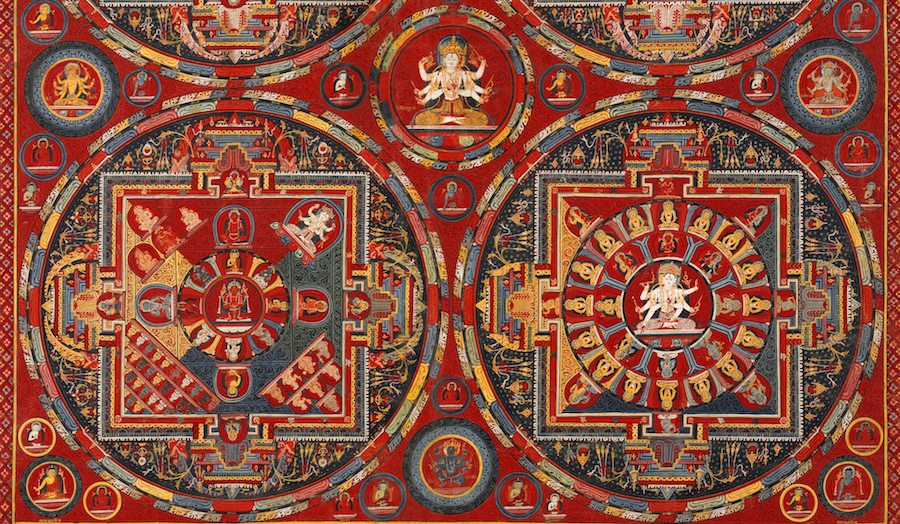 Central Tibet, Tsang (Ngor_Monastery) Four Mandalas of the Vajravali Series.
Central Tibet, Tsang (Ngor_Monastery) Four Mandalas of the Vajravali Series. 

